SpringBoot
如何写一个网站
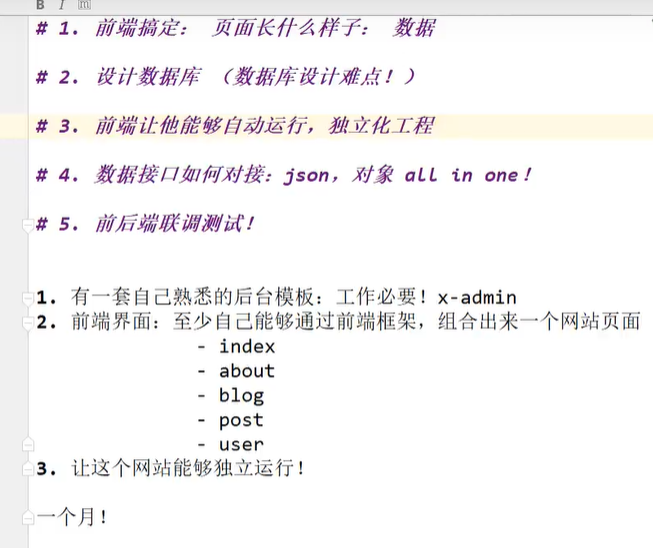
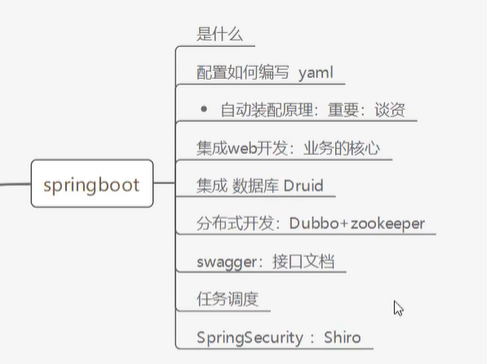
微服务架构
微服务
什么是微服务?
微服务是一种架构风格,它要求我们在开发一个应用的时候,这个应用必须构建成―系列小服务的组合;可以通过http的方式进行互通。要说微服务架构,先得说说过去我们的单体应用架构。
单体应用架构
所谓单体应用架构(all in one)是指,我们将一个应用的中的所有应用服务都封装在一个应用中。
无论是ERP、CRM或是其他什么系统,你都把数据库访问,web访问,等等各个功能放到一个war包内。
这样做的好处是,易于开发和测试;也十分方便部署;当需要扩展时,只需要将war复制多份,然后放到多个服务器上,再做个负载均衡就可以了。
单体应用架构的缺点是,哪怕我要修改一个非常小的地方,我都需要停掉整个服务,重新打包、部署这个应用war包。特别是对于一个大型应用,我们不可能吧所有内容都放在一个应用里面,我们如何维护、如何分工合作都是问题。
微服务架构
all in one的架构方式,我们把所有的功能单元放在一个应用里面。然后我们把整个应用部署到服务器上。如果负载能力不行,我们将整个应用进行水平复制,进行扩展,然后在负载均衡。
所谓微服务架构,就是打破之前all in one的架构方式,把每个功能元素独立出来。把独立出来的功能元素的动态组合,需要的功能元素才去拿来组合,需要多一些时可以整合多个功能元素。所以微服务架构是对功能元素进行复制,而没有对整个应用进行复制。
这样做的好处是:
1.节省了调用资源。
2.每个功能元素的服务都是一个可替换的、可独立升级的软件代码。
如何构建微服务
一个大型系统的微服务架构,就像一个复杂交织的神经网络,每一个神经元就是一个功能元素,它们各自完成自己的功能,然后通过http相互请求调用。比如一个电商系统,查缓存、连数据库、浏览页面、结账、支付等服务都是一个个独立的功能服务,都被微化了,它们作为一个个微服务共同构建了一个庞大的系统。如果修改其中的一个功能,只需要更新升级其中一个功能服务单元即可。
但是这种庞大的系统架构给部署和运维带来很大的难度。于是,spring为我们带来了构建大型分布式微服务的全套、全程产品:
构建一个个功能独立的微服务应用单元,可以使用springboot,可以帮我们快速构建一个应用;
大型分布式网络服务的调用,这部分由spring cloud来完成,实现分布式;
在分布式中间,进行流式数据计算、批处理,我们有s pring cloud data flow。
spring为我们想清楚了整个从开始构建应用到大型分布式应用全流程方案。
第一个SpringBoot程序
创建
直接新建一个项目,使用Spring Initializr
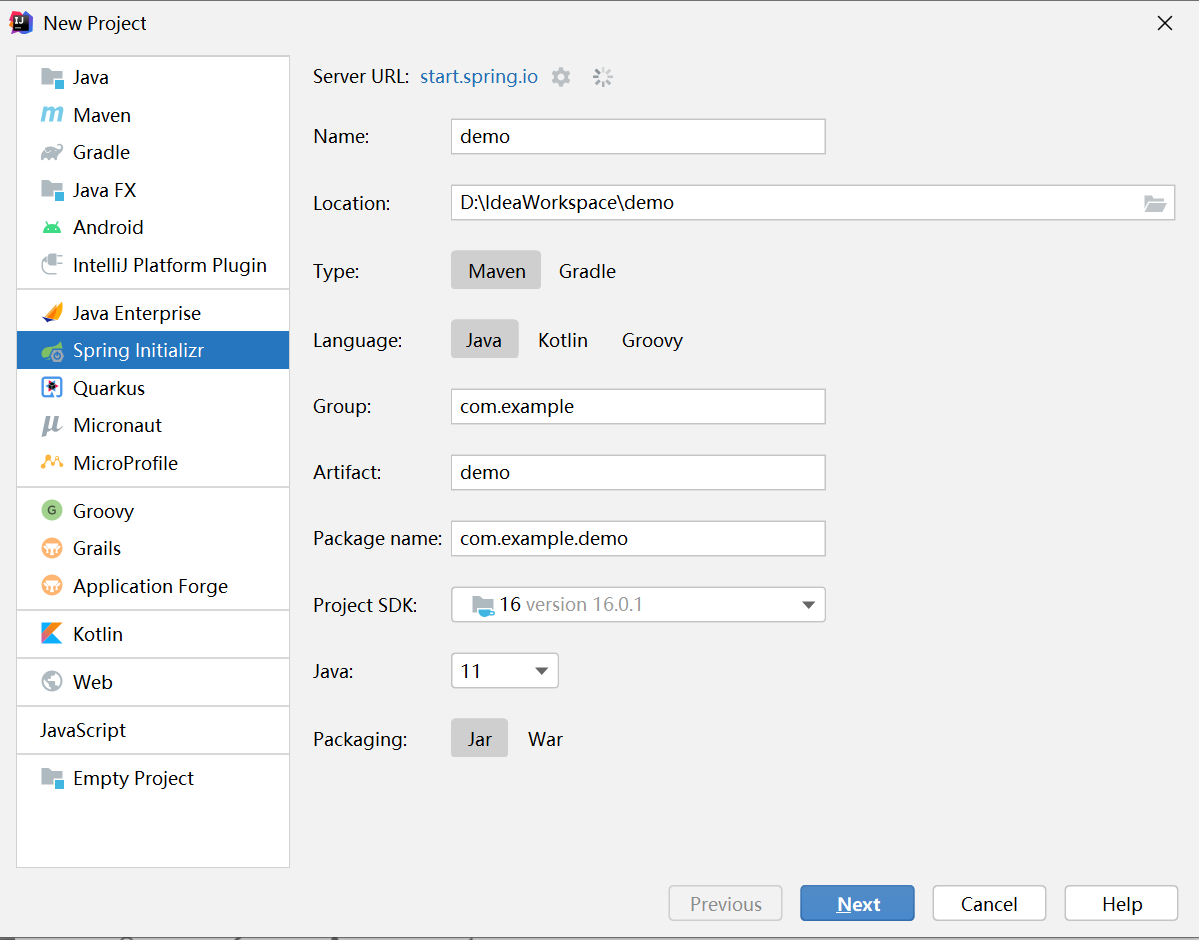
这里可以添加框架,可以自动导入jar包
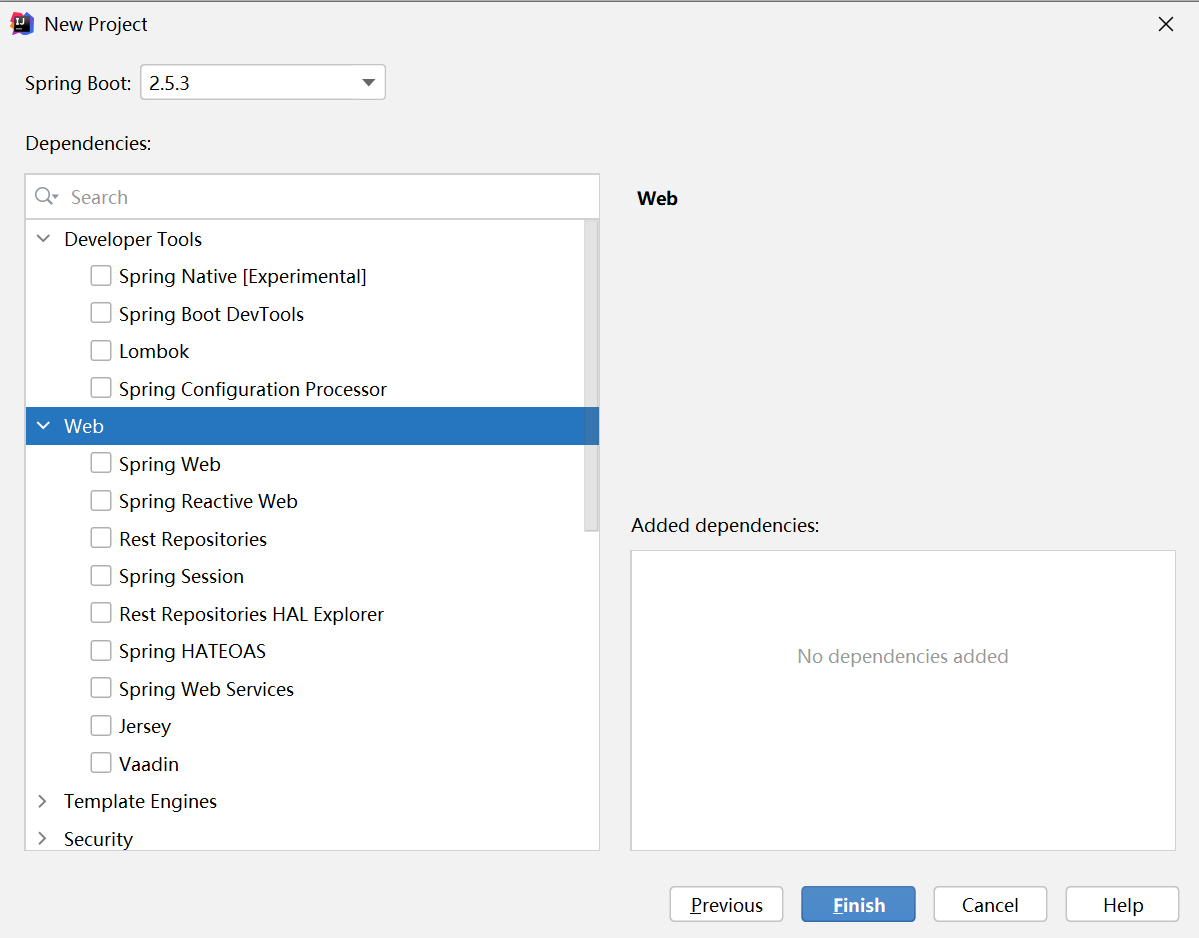
在同级目录建立各种目录,就可以开始开发了
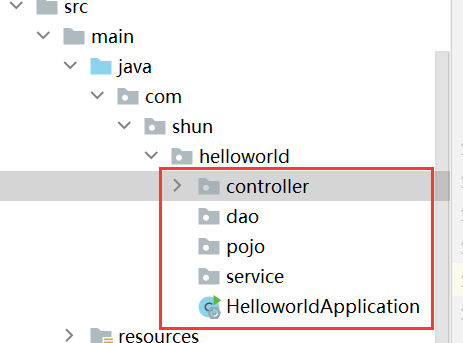
初测试
package com.shun.helloworld.controller;
import org.springframework.web.bind.annotation.RequestMapping;
import org.springframework.web.bind.annotation.RestController;
@RestController
public class HelloController {
@RequestMapping("/hello")
public String hello(){
return "hello,world!";
}
}

更改端口号
在properties配置文件中设置即可

自定义banner
https://www.bootschool.net/ascii-art/comic
可以在这个网站上去定义banner样式
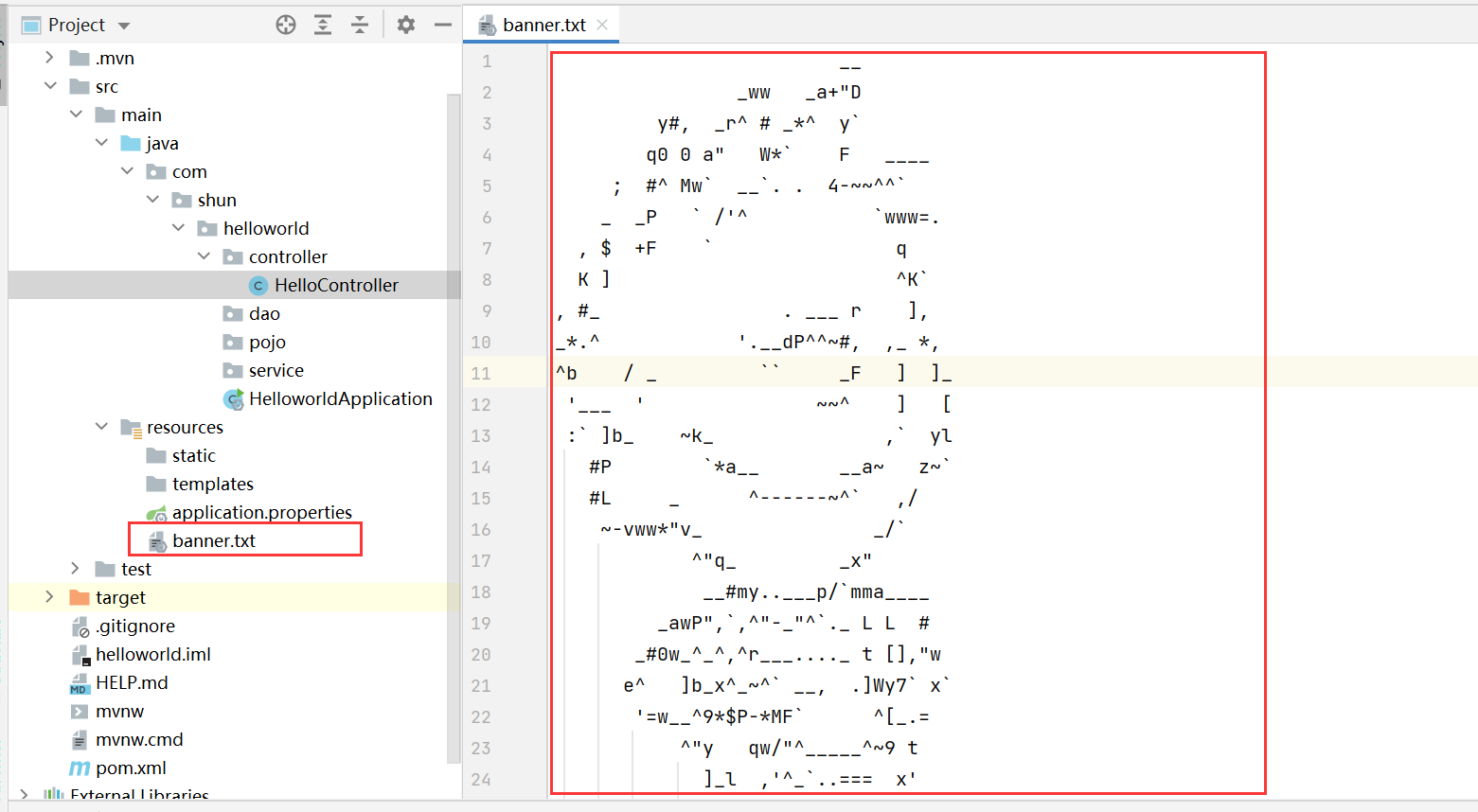
启动后,本来是Spring字样,现在变成自定义了
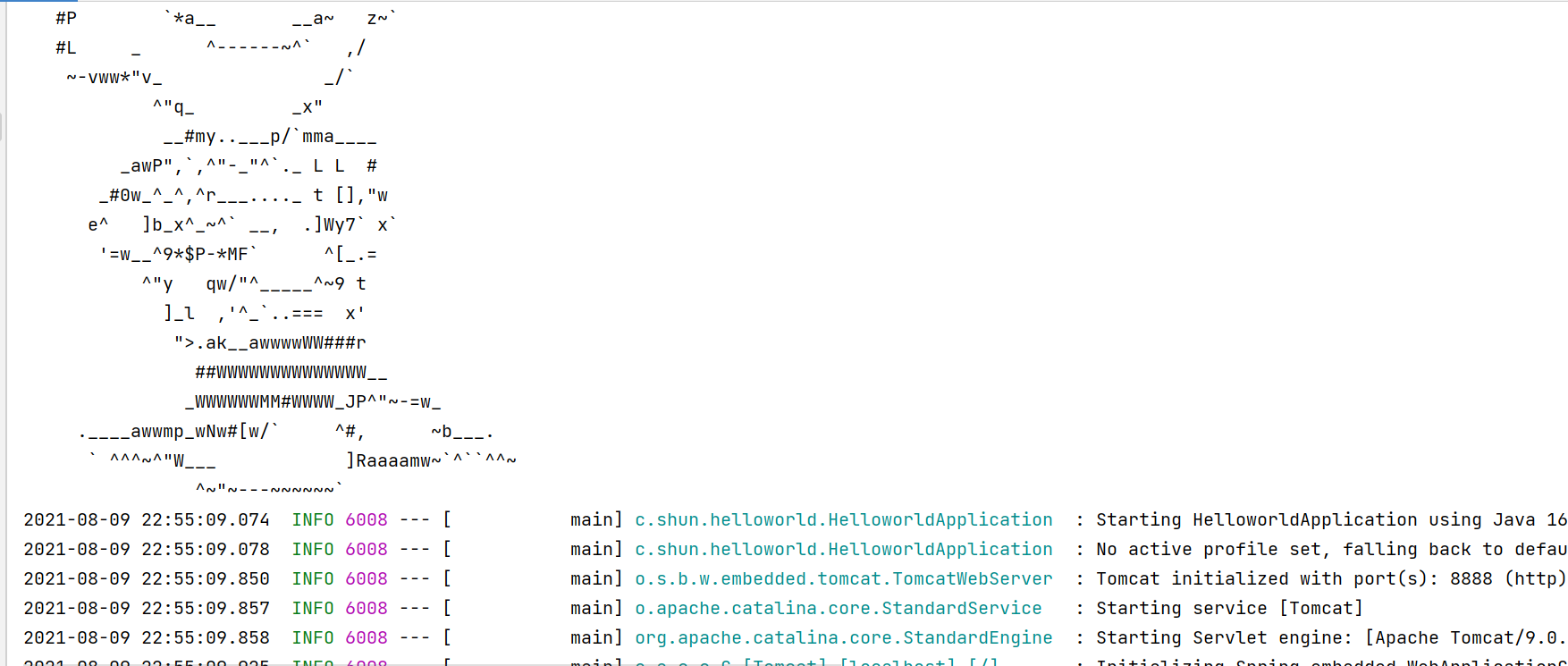
yaml语法
配置文件
SpringBoot使用一个全局的配置文件,配置文件名称是固定的
application.properties
- 语法结构: key=value
application.yml
- 语法结构: key:空格value
配置文件的作用∶修改SpringBoot自动配置的默认值,因为SpringBoot在底层都给我们自动配置好了;
YAML
简介
YAML 语言(发音 /ˈjæməl/ )的设计目标,就是方便人类读写。它实质上是一种通用的数据串行化格式。
它的基本语法规则如下。
- 大小写敏感
- 使用缩进表示层级关系
- 缩进时不允许使用Tab键,只允许使用空格。
- 缩进的空格数目不重要,只要相同层级的元素左侧对齐即可
# 表示注释,从这个字符一直到行尾,都会被解析器忽略。
YAML 支持的数据结构有三种。
- 对象:键值对的集合,又称为映射(mapping)/ 哈希(hashes) / 字典(dictionary)
- 数组:一组按次序排列的值,又称为序列(sequence) / 列表(list)
- 纯量(scalars):单个的、不可再分的值
1、对象
对象的一组键值对,使用冒号结构表示。
animal: pets
转为 JavaScript 如下。
{ animal: 'pets' }
Yaml 也允许另一种写法,将所有键值对写成一个行内对象。
hash: { name: Steve, foo: bar }
转为 JavaScript 如下。
{ hash: { name: 'Steve', foo: 'bar' } }
2、数组
一组连词线开头的行,构成一个数组。
- Cat - Dog - Goldfish
转为 JavaScript 如下。
[ 'Cat', 'Dog', 'Goldfish' ]
数据结构的子成员是一个数组,则可以在该项下面缩进一个空格。
- - Cat - Dog - Goldfish
转为 JavaScript 如下。
[ [ 'Cat', 'Dog', 'Goldfish' ] ]
数组也可以采用行内表示法。
animal: [Cat, Dog]
转为 JavaScript 如下。
{ animal: [ 'Cat', 'Dog' ] }
3、复合结构
对象和数组可以结合使用,形成复合结构。
languages: - Ruby - Perl - Python websites: YAML: yaml.org Ruby: ruby-lang.org Python: python.org Perl: use.perl.org
转为 JavaScript 如下。
{ languages: [ 'Ruby', 'Perl', 'Python' ], websites: { YAML: 'yaml.org', Ruby: 'ruby-lang.org', Python: 'python.org', Perl: 'use.perl.org' } }
4、纯量
纯量是最基本的、不可再分的值。以下数据类型都属于 JavaScript 的纯量。
- 字符串
- 布尔值
- 整数
- 浮点数
- Null
- 时间
- 日期
数值直接以字面量的形式表示。
number: 12.30
转为 JavaScript 如下。
{ number: 12.30 }
布尔值用true和false表示。
isSet: true
转为 JavaScript 如下。
{ isSet: true }
null用~表示。
parent: ~
转为 JavaScript 如下。
{ parent: null }
时间采用 ISO8601 格式。
iso8601: 2001-12-14t21:59:43.10-05:00
转为 JavaScript 如下。
{ iso8601: new Date('2001-12-14t21:59:43.10-05:00') }
日期采用复合 iso8601 格式的年、月、日表示。
date: 1976-07-31
转为 JavaScript 如下。
{ date: new Date('1976-07-31') }
YAML 允许使用两个感叹号,强制转换数据类型。
e: !!str 123 f: !!str true
转为 JavaScript 如下。
{ e: '123', f: 'true' }
5、字符串
字符串是最常见,也是最复杂的一种数据类型。
字符串默认不使用引号表示。
str: 这是一行字符串
转为 JavaScript 如下。
{ str: '这是一行字符串' }
如果字符串之中包含空格或特殊字符,需要放在引号之中。
str: '内容: 字符串'
转为 JavaScript 如下。
{ str: '内容: 字符串' }
单引号和双引号都可以使用,双引号不会对特殊字符转义。
s1: '内容\n字符串' s2: "内容\n字符串"
转为 JavaScript 如下。
{ s1: '内容\\n字符串', s2: '内容\n字符串' }
单引号之中如果还有单引号,必须连续使用两个单引号转义。
str: 'labor''s day'
转为 JavaScript 如下。
{ str: 'labor\'s day' }
字符串可以写成多行,从第二行开始,必须有一个单空格缩进。换行符会被转为空格。
str: 这是一段 多行 字符串
转为 JavaScript 如下。
{ str: '这是一段 多行 字符串' }
多行字符串可以使用|保留换行符,也可以使用>折叠换行。
this: | Foo Bar that: > Foo Bar
转为 JavaScript 代码如下。
{ this: 'Foo\nBar\n', that: 'Foo Bar\n' }
+表示保留文字块末尾的换行,-表示删除字符串末尾的换行。
s1: | Foo s2: |+ Foo s3: |- Foo
转为 JavaScript 代码如下。
{ s1: 'Foo\n', s2: 'Foo\n\n\n', s3: 'Foo' }
字符串之中可以插入 HTML 标记。
message: | <p style="color: red"> 段落 </p>
转为 JavaScript 如下。
{ message: '\n<p style="color: red">\n 段落\n</p>\n' }
6、引用
锚点&和别名*,可以用来引用。
defaults: &defaults adapter: postgres host: localhost development: database: myapp_development <<: *defaults test: database: myapp_test <<: *defaults
等同于下面的代码。
defaults: adapter: postgres host: localhost development: database: myapp_development adapter: postgres host: localhost test: database: myapp_test adapter: postgres host: localhost
&用来建立锚点(defaults),<<表示合并到当前数据,*用来引用锚点。
下面是另一个例子。
- &showell Steve - Clark - Brian - Oren - *showell
转为 JavaScript 代码如下。
[ 'Steve', 'Clark', 'Brian', 'Oren', 'Steve' ]
7、函数和正则表达式的转换
这是 JS-YAML 库特有的功能,可以把函数和正则表达式转为字符串。
# example.yml fn: function () { return 1 } reg: /test/
解析上面的 yml 文件的代码如下。
var yaml = require('js-yaml'); var fs = require('fs'); try { var doc = yaml.load( fs.readFileSync('./example.yml', 'utf8') ); console.log(doc); } catch (e) { console.log(e); }
从 JavaScript 对象还原到 yaml 文件的代码如下。
var yaml = require('js-yaml'); var fs = require('fs'); var obj = { fn: function () { return 1 }, reg: /test/ }; try { fs.writeFileSync( './example.yml', yaml.dump(obj), 'utf8' ); } catch (e) { console.log(e); }
属性赋值
实体类以及配置文件
@Component
public class Dog {
@Value("旺财")
private String name;
@Value("3")
private Integer age;/*
configurationProperties作用:
将配置文件中配置的每一个属性的值,映射到这个组件中;
告诉SpringBoot将本类中的所有属性和配置文件中相关的配置进行绑定
参数 prefix = "person":将配置文件中的person下面的所有属性—─对应
只有这个组件是容器中的组件,才能使用容器提供的configurationProperties功能
*/
@Component
@ConfigurationProperties(prefix = "person")
public class Person {
private String name;
private Integer age;
private Boolean happy;
private Date brithday;
private Map<String, Object> maps;
private List<Object> lists;
private Dog dog;
@Component
public class Dog {
@Value("旺财")
private String name;
@Value("3")
private Integer age;
person:
name: liushun
age: 3
happy: true
brithday: 2021/1/1
maps: {k1: v1, k2: v2}
lists:
- code
- music
- play
dog:
name: 旺财
age: 4
测试
@Autowired
private Dog dog;
@Autowired
private Person person;
@Test
void contextLoads() {
System.out.println(dog);
System.out.println(person);
}
Dog{name='旺财', age=3}
Person{name='liushun', age=3, happy=true, brithday=Fri Jan 01 00:00:00 CST 2021, maps={k1=v1, k2=v2}, lists=[code, music, play], dog=Dog{name='旺财', age=4}}
对比图

- cp只需要写一次即可, value则需要每个字段都添加
- 松散绑定:这个什么意思呢?比如我的yml中写的last-name,这个和lastName是一样的,–后面跟着的字母默认是大写的。这就是松散绑定
- JSR303数据校验,这个就是我们可以在字段是增加一层过滤器验证,可以保证数据的合法性复杂类型封装,yml中可以封装对象,使用@value就不支持
结论
- 配置yml和配置properties都可以获取到值,强烈推荐yml
- 如果我们在某个业务中,只需要获取配置文件中的某个值,可以使用一下@value
- 如果说,我们专门编写了一个JavaBean来和配置文件进行映射,就直接使用@configurationProperties,不要犹豫!
JSR303校验
JSR-303 是 JAVA EE 6 中的一项子规范,叫做 Bean Validation,官方参考实现是Hibernate Validator。
此实现与 Hibernate ORM 没有任何关系。 JSR 303 用于对 Java Bean 中的字段的值进行验证。
Spring MVC 3.x 之中也大力支持 JSR-303,可以在控制器中对表单提交的数据方便地验证。
基本校验规则
空检查 @Null 验证对象是否为null @NotNull 验证对象是否不为null, 无法查检长度为0的字符串 @NotBlank 检查约束字符串是不是Null还有被Trim的长度是否大于0,只对字符串,且会去掉前后空格. @NotEmpty 检查约束元素是否为NULL或者是EMPTY.
Booelan检查 @AssertTrue 验证 Boolean 对象是否为 true @AssertFalse 验证 Boolean 对象是否为 false
长度检查 @Size(min=, max=) 验证对象(Array,Collection,Map,String)长度是否在给定的范围之内 @Length(min=, max=) Validates that the annotated string is between min and max included.
日期检查 @Past 验证 Date 和 Calendar 对象是否在当前时间之前,验证成立的话被注释的元素一定是一个过去的日期 @Future 验证 Date 和 Calendar 对象是否在当前时间之后 ,验证成立的话被注释的元素一定是一个将来的日期 @Pattern 验证 String 对象是否符合正则表达式的规则,被注释的元素符合制定的正则表达式,regexp:正则表达式 flags: 指定 Pattern.Flag 的数组,表示正则表达式的相关选项。
数值检查 建议使用在Stirng,Integer类型,不建议使用在int类型上,因为表单值为“”时无法转换为int,但可以转换为Stirng为”“,Integer为null @Min 验证 Number 和 String 对象是否大等于指定的值 @Max 验证 Number 和 String 对象是否小等于指定的值 @DecimalMax 被标注的值必须不大于约束中指定的最大值. 这个约束的参数是一个通过BigDecimal定义的最大值的字符串表示.小数存在精度 @DecimalMin 被标注的值必须不小于约束中指定的最小值. 这个约束的参数是一个通过BigDecimal定义的最小值的字符串表示.小数存在精度 @Digits 验证 Number 和 String 的构成是否合法 @Digits(integer=,fraction=) 验证字符串是否是符合指定格式的数字,interger指定整数精度,fraction指定小数精度。 @Range(min=, max=) 被指定的元素必须在合适的范围内 @Range(min=10000,max=50000,message=”range.bean.wage”) @Valid 递归的对关联对象进行校验, 如果关联对象是个集合或者数组,那么对其中的元素进行递归校验,如果是一个map,则对其中的值部分进行校验.(是否进行递归验证) @CreditCardNumber信用卡验证 @Email 验证是否是邮件地址,如果为null,不进行验证,算通过验证。 @ScriptAssert(lang= ,script=, alias=) @URL(protocol=,host=, port=,regexp=, flags=)
案例
public class Order {
// 必须不为 null, 大小是 10
@NotNull
@Size(min = 10, max = 10)
private String orderId;
// 必须不为空
@NotEmpty
private String customer;
// 必须是一个电子信箱地址
@Email
private String email;
// 必须不为空
@NotEmpty
private String address;
// 必须不为 null, 必须是下面四个字符串'created', 'paid', 'shipped', 'closed'其中之一
// @Status 是一个定制化的 contraint
@NotNull
@Status
private String status;
// 必须不为 null
@NotNull
private Date createDate;
// 嵌套验证
@Valid
private Product product;
// getter 和setter方法
}
多环境配置
多环境选择
直接在一个yml文件中写多套配置,用三条横线分割,然后规定使用哪一套配置即可
也可以使用多文件,application-dev.yml格式命名
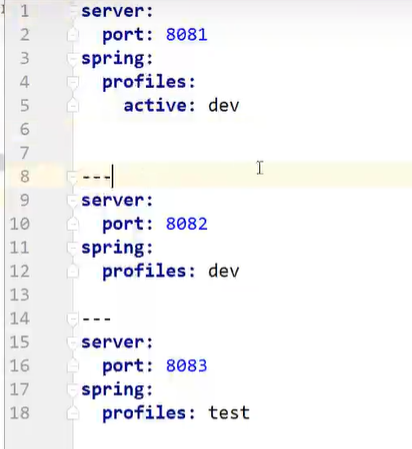
自动配置初原理
1)SpringBoot启动会加载大量的自动配置类
2)我们看我们需要的功能有没有在SpringBoot默认写好的自动配置类当中;
3)我们再来看这个自动配置类中到底配置了哪些组件;(只要我们要用的组件存在在其中,我们就不需要再手动配置了)
4)给容器中自动配置类添加组件的时候,会从properties类中获取某些属性。我们只需要在配置文件中指定这些属性的值即可;
xxxxAutoConfigurartion:自动配置类;给容器中添加组件
xxxxProperties:封装配置文件中相关属性;
查看生效配置
可以通过debug=true来查看,哪些自动配置类生效,哪些没有生效!
debug: true
SpringBoot Web开发
静态资源导入

如果没有自定义的话,静态资源一般可以放在三个目录下,分别在resources目录下的resources,static,public,且优先级和顺序一致,即public优先级最低
而templates下面的页面只能通过controller才跳转,其余的可以通过url直接访问
首页
所以在上面三个路径下新建一个index.html即可
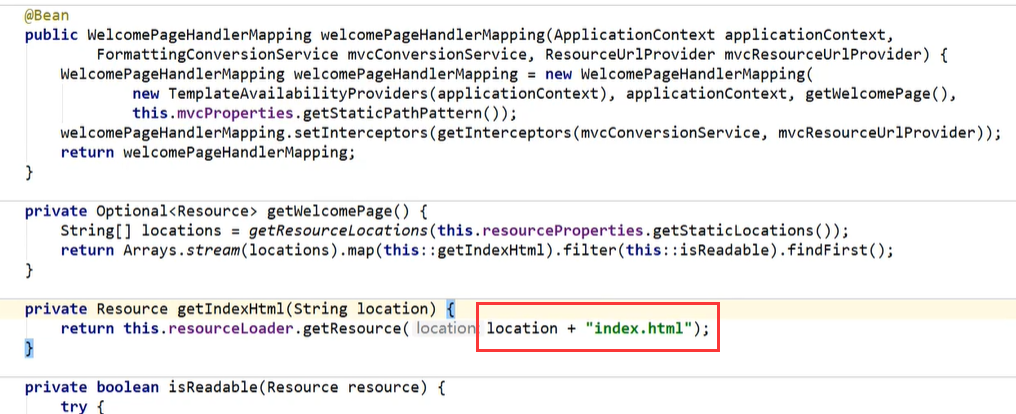
模板引擎thymeleaf
简介
模板引擎的作用就是我们来写一个页面模板,比如有些值呢,是动态的,我们写一些表达式。而这些值,从哪来呢,我们来组装一些数据,我们把这些数据找到。然后把这个模板和这个数据交给我们模板引擎,模板引擎按照我们这个数据帮你把这表达式解析、填充到我们指定的位置,然后把这个数据最终生成一个我们想要的内容给我们写出去,这就是我们这个模板引擎,不管是jsp还是其他模板引擎,都是这个思想。
不同模板引擎之间,他们可能这个语法有点不一样。
SpringBoot给我们推荐的Thymeleaf模板引擎是一个高级语言的模板引擎,他的这个语法更简单。而且呢,功能更强大。
源码

依赖
<!-- thymeleaf 基于3.x开发-->
<dependency>
<groupId>org.thymeleaf</groupId>
<artifactId>thymeleaf-spring5</artifactId>
</dependency>
<dependency>
<groupId>org.thymeleaf.extras</groupId>
<artifactId>thymeleaf-extras-java8time</artifactId>
</dependency>
简单使用
<!DOCTYPE html>
<html lang="en" xmlns:th="http://www.thymeleaf.org">
<head>
<meta charset="UTF-8">
<title>Title</title>
</head>
<body>
<!--文本,不转义-->
<div th:text="${msg}"></div>
<!--文本转义-->
<div th:utext="${msg}"></div>
<!--换行线-->
<hr>
<!--遍历-->
<h3 th:each="user:${users}" th:text="${user}"></h3>
<!--<h3 th:each="user:${users}">[[ ${user} ]]</h3>-->
</body>
</html>
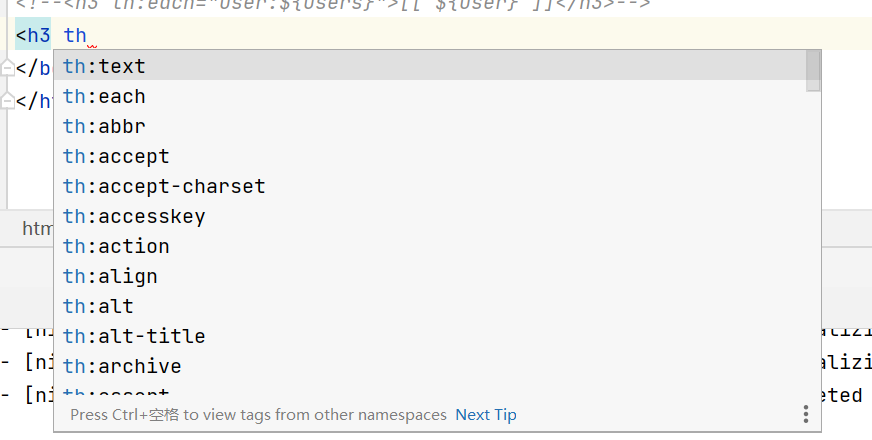
有很多用法,可以看文档https://www.thymeleaf.org/doc/tutorials/3.0/usingthymeleaf.html#standard-expression-syntax
简单使用规则
- Simple expressions:
- Variable Expressions:
${...} - Selection Variable Expressions:
*{...} - Message Expressions:
#{...} - Link URL Expressions:
@{...} - Fragment Expressions:
~{...}
- Variable Expressions:
- Literals
- Text literals:
'one text','Another one!',… - Number literals:
0,34,3.0,12.3,… - Boolean literals:
true,false - Null literal:
null - Literal tokens:
one,sometext,main,…
- Text literals:
- Text operations:
- String concatenation:
+ - Literal substitutions:
|The name is ${name}|
- String concatenation:
- Arithmetic operations:
- Binary operators:
+,-,*,/,% - Minus sign (unary operator):
-
- Binary operators:
- Boolean operations:
- Binary operators:
and,or - Boolean negation (unary operator):
!,not
- Binary operators:
- Comparisons and equality:
- Comparators:
>,<,>=,<=(gt,lt,ge,le) - Equality operators:
==,!=(eq,ne)
- Comparators:
- Conditional operators:
- If-then:
(if) ? (then) - If-then-else:
(if) ? (then) : (else) - Default:
(value) ?: (defaultvalue)
- If-then:
- Special tokens:
- No-Operation:
_
- No-Operation:
SpringMVC扩展--配置
所有的配置扩展,只需要继承一个接口,然后添加一个注解,就可以生效
package com.shun.helloworld.config;
import org.springframework.context.annotation.Configuration;
import org.springframework.web.servlet.config.annotation.ViewControllerRegistry;
import org.springframework.web.servlet.config.annotation.WebMvcConfigurer;
//如果要扩展springmvc配置,就可以写一个配置类,添加configuration注解
@Configuration
public class MyMvcConfig implements WebMvcConfigurer {
//视图跳转
@Override
public void addViewControllers(ViewControllerRegistry registry) {
registry.addViewController("/shun").setViewName("test");
}
}
结果

员工管理系统
首先还没有数据库,所以需要模拟数据库操作
1、导入静态资源
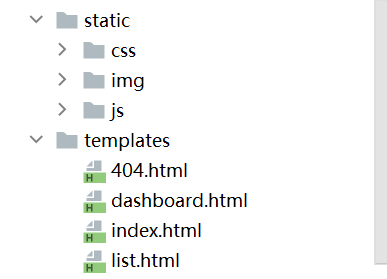
这里需要注意的是t'hth
2、创建各种类
pojo
可以导入lombok依赖,实现自动装配方法
//部门表
public class Department {
private Integer id;
private String departmentName;
//员工表
public class Employee {
private Integer id;
private String lastName;
private String email;
private Integer gender;//0 女 1 男
private Department department;
private Date birth;
dao
记得加**@Repository**这个注解
package com.shun.helloworld.dao;
import com.shun.helloworld.pojo.Department;
import java.util.Collection;
import java.util.HashMap;
import java.util.Map;
//部门dao
@Repository
public class DepartmentDao {
//模拟数据库
private static Map<Integer, Department> departmentMap = null;
static {
departmentMap = new HashMap<Integer, Department>();
departmentMap.put(101, new Department(101, "教学部"));
departmentMap.put(102, new Department(102, "实践部"));
departmentMap.put(103, new Department(103, "后勤部"));
departmentMap.put(104, new Department(104, "保卫部"));
departmentMap.put(105, new Department(105, "监督部"));
departmentMap.put(106, new Department(106, "集资部"));
}
//操作
//获得所有部门信息
public Collection<Department> getDepartments(){
return departmentMap.values();
}
//通过Id得到部门
public Department getDepartmentById(Integer id){
return departmentMap.get(id);
}
}
package com.shun.helloworld.dao;
import com.shun.helloworld.pojo.Department;
import com.shun.helloworld.pojo.Employee;
import org.springframework.beans.factory.annotation.Autowired;
import java.util.Collection;
import java.util.Date;
import java.util.HashMap;
import java.util.Map;
@Repository
public class EmployeeDao {
//模拟数据库
private static Map<Integer, Employee> employeeMap = null;
//员工所属部门
@Autowired
private DepartmentDao departmentDao;
static {
employeeMap = new HashMap<Integer, Employee>();
employeeMap.put(1001, new Employee(1001, "aa", "1143760069@qq.com", 1, new Department(101, "教学部"), new Date()));
employeeMap.put(1001, new Employee(1001, "bb", "2243760069@qq.com", 0, new Department(102, "实践部"), new Date()));
employeeMap.put(1001, new Employee(1001, "cc", "3343760069@qq.com", 1, new Department(103, "后勤部"), new Date()));
employeeMap.put(1001, new Employee(1001, "dd", "4443760069@qq.com", 0, new Department(104, "保卫部"), new Date()));
employeeMap.put(1001, new Employee(1001, "ee", "5543760069@qq.com", 1, new Department(105, "监督部"), new Date()));
employeeMap.put(1001, new Employee(1001, "ff", "6643760069@qq.com", 0, new Department(106, "集资部"), new Date()));
}
//主键自增
private static Integer initId = 1006;
//操作
public void add(Employee employee){
if(employee.getId() == null){
employee.setId(initId++);
}
employee.setDepartment(departmentDao.getDepartmentById(employee.getDepartment().getId()));
employeeMap.put(employee.getId(), employee);
}
//查询员工
public Collection<Employee> getAll(){
return employeeMap.values();
}
public Employee getEmployeeById(Integer id){
return employeeMap.get(id);
}
public void deleteById(Integer id){
employeeMap.remove(id);
}
}
3、首页实现
配置扩展实现首页的显示
package com.shun.helloworld.config;
import org.springframework.context.annotation.Configuration;
import org.springframework.web.servlet.config.annotation.ViewControllerRegistry;
import org.springframework.web.servlet.config.annotation.WebMvcConfigurer;
//如果要扩展springmvc配置,就可以写一个配置类,添加configuration注解
@Configuration
public class MyMvcConfig implements WebMvcConfigurer {
@Override
public void addViewControllers(ViewControllerRegistry registry) {
registry.addViewController("/").setViewName("index");
registry.addViewController("/index.html").setViewName("index");
}
}
4、国际化
1、i18n配置编写
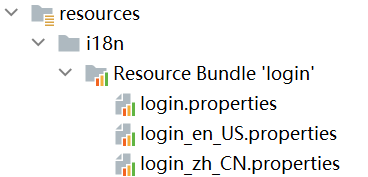
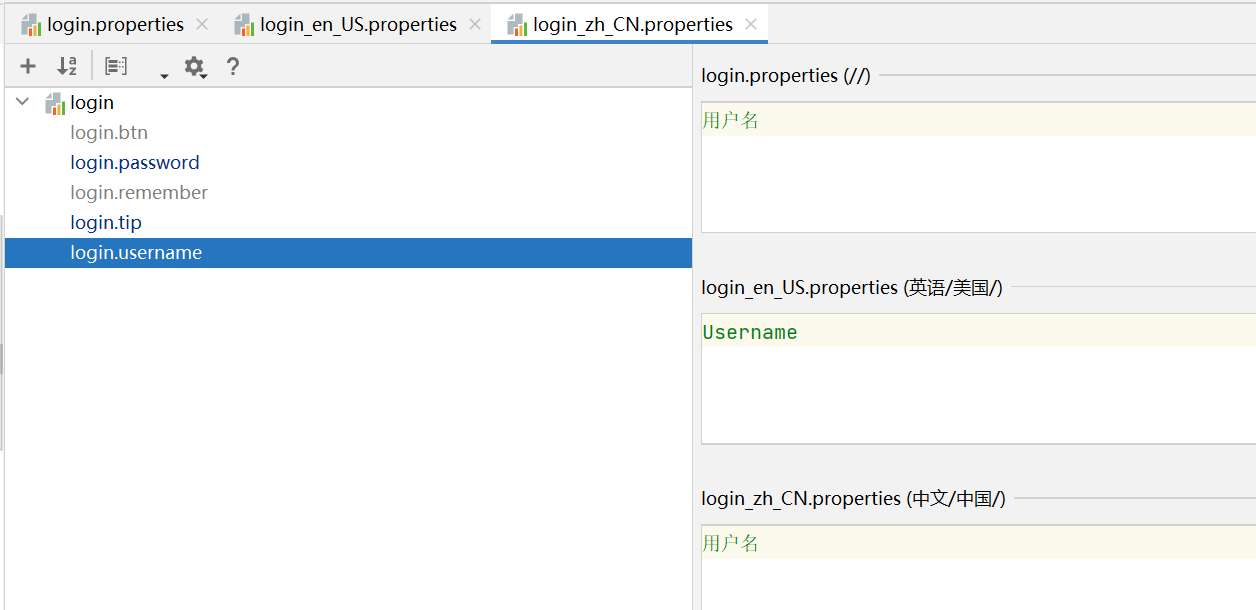
2、前端页面链接选择
<a class="btn btn-sm" th:href="@{/index.html(language='zh_CN')}">中文</a>
<a class="btn btn-sm" th:href="@{/index.html(language='en_US')}">English</a>
3、编写自己的国际化解析器LocaleResolver
package com.shun.helloworld.config;
import org.springframework.util.StreamUtils;
import org.springframework.util.StringUtils;
import org.springframework.web.servlet.LocaleResolver;
import javax.servlet.http.HttpServletRequest;
import javax.servlet.http.HttpServletResponse;
import java.util.Locale;
public class MyLocaleResolver implements LocaleResolver {
//解析请求
@Override
public Locale resolveLocale(HttpServletRequest httpServletRequest) {
//获取参数
String language = httpServletRequest.getParameter("language");
Locale aDefault = Locale.getDefault();
if (!StringUtils.isEmpty(language)) {
String[] s = language.split("_");
aDefault = new Locale(s[0], s[1]);
}
return aDefault;
}
@Override
public void setLocale(HttpServletRequest httpServletRequest, HttpServletResponse httpServletResponse, Locale locale) {
}
}
4、注册到容器
在扩展配置中注册
//注入 自定义国际化组件到 spring 容器
@Bean
public LocaleResolver localeResolver(){
return new MyLocaleResolver();
}
5、界面展示
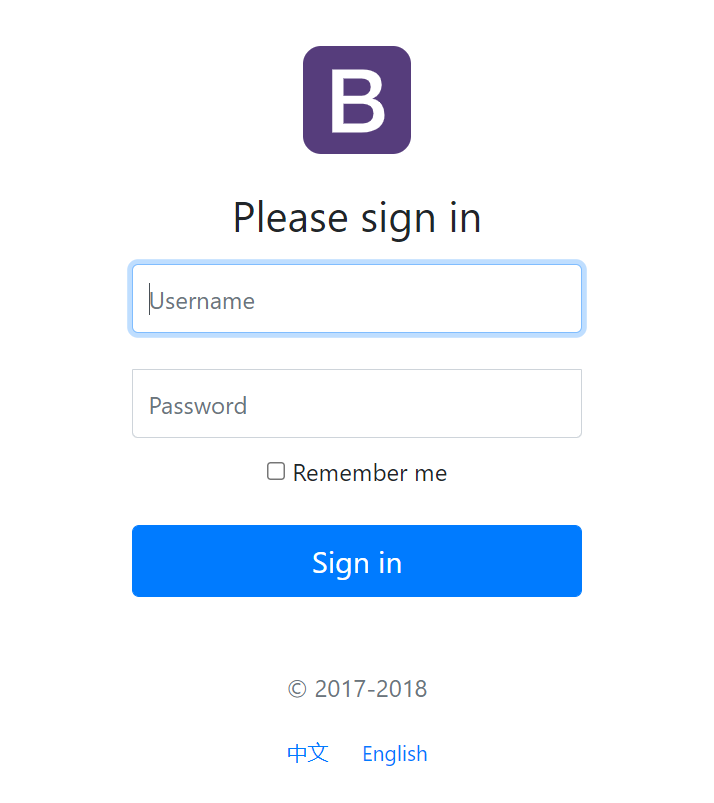
5、登陆界面及拦截器
LoginController
package com.shun.helloworld.controller;
import org.springframework.stereotype.Controller;
import org.springframework.ui.Model;
import org.springframework.util.StringUtils;
import org.springframework.web.bind.annotation.RequestMapping;
import org.springframework.web.bind.annotation.RequestParam;
import javax.servlet.http.HttpSession;
@Controller
public class LoginController {
@RequestMapping("/user/login")
public String login(@RequestParam("username") String username,
@RequestParam("password") String password,
Model model, HttpSession session){
//业务
if (!StringUtils.isEmpty(username) && "123456".equals(password)){
session.setAttribute("loginUser", username);
return "redirect:/main.html";
}else {
model.addAttribute("msg", "用户名或密码错误");
return "index";
}
}
}

一般我们会让他重定向到main.html请求,然后视图解析器直接将main.html映射到我们的主页
拦截器
写在config中
首先需要自己写拦截器类,根据session中有没有数据判断是否登陆成功
package com.shun.helloworld.config;
import org.springframework.web.servlet.HandlerInterceptor;
import javax.servlet.http.HttpServletRequest;
import javax.servlet.http.HttpServletResponse;
public class LoginHandlerInterceptor implements HandlerInterceptor {
@Override
public boolean preHandle(HttpServletRequest request, HttpServletResponse response, Object handler) throws Exception {
Object loginUser = request.getSession().getAttribute("loginUser");
if (loginUser == null){
request.setAttribute("msg", "没有权限,请先登录");
request.getRequestDispatcher("/index.html").forward(request,response);
return false;
}
return true;
}
}
注册拦截器到容器中
addPathPatterns是添加拦截器的url,excludePathPatterns是不添加的路径,一般登陆页面请求,以及一些静态资源不添加
//登陆拦截器
@Override
public void addInterceptors(InterceptorRegistry registry) {
registry.addInterceptor(new LoginHandlerInterceptor())
.addPathPatterns("/**")
.excludePathPatterns("/index.html", "/", "/user/login", "/static/**");
}
6、展示员工列表
1、前端公共页面抽离

2、前端公共页面引用

3、页面选择栏高亮
一个传递参数 list.html

一个接收参数并判断 commons.html

4、页面展示Controller
package com.shun.helloworld.controller;
import com.shun.helloworld.dao.EmployeeDao;
import com.shun.helloworld.pojo.Employee;
import org.springframework.beans.factory.annotation.Autowired;
import org.springframework.stereotype.Controller;
import org.springframework.ui.Model;
import org.springframework.web.bind.annotation.RequestMapping;
import java.util.Collection;
@Controller
public class EmployeeController {
@Autowired
EmployeeDao employeeDao;
@RequestMapping("/emps")
public String list(Model model){
Collection<Employee> employees = employeeDao.getAll();
model.addAttribute("emps", employees);
System.out.println("00000");
return "emp/list";
}
}
5、前端员工数据展示
<main role="main" class="col-md-9 ml-sm-auto col-lg-10 pt-3 px-4">
<h2>员工列表</h2>
<div class="table-responsive">
<table class="table table-striped table-sm">
<thead>
<tr>
<th>id</th>
<th>lastName</th>
<th>email</th>
<th>gender</th>
<th>department</th>
<th>birth</th>
<th>操作</th>
</tr>
</thead>
<tbody>
<tr th:each="emp:${emps}">
<td th:text="${emp.getId()}"></td>
<td th:text="${emp.getLastName()}"></td>
<td th:text="${emp.getEmail()}"></td>
<td th:text="${emp.getGender()==0?'女':'男'}"></td>
<td th:text="${emp.getDepartment().getDepartmentName()}"></td>
<td th:text="${#dates.format(emp.getBirth(), 'yyyy-MM-dd')}"></td>
<td>
<button class="btn btn-sm btn-primary">编辑</button>
<button class="btn btn-sm btn-danger">删除</button>
</td>
</tr>
</tbody>
</table>
</div>
</main>
6、结果展示
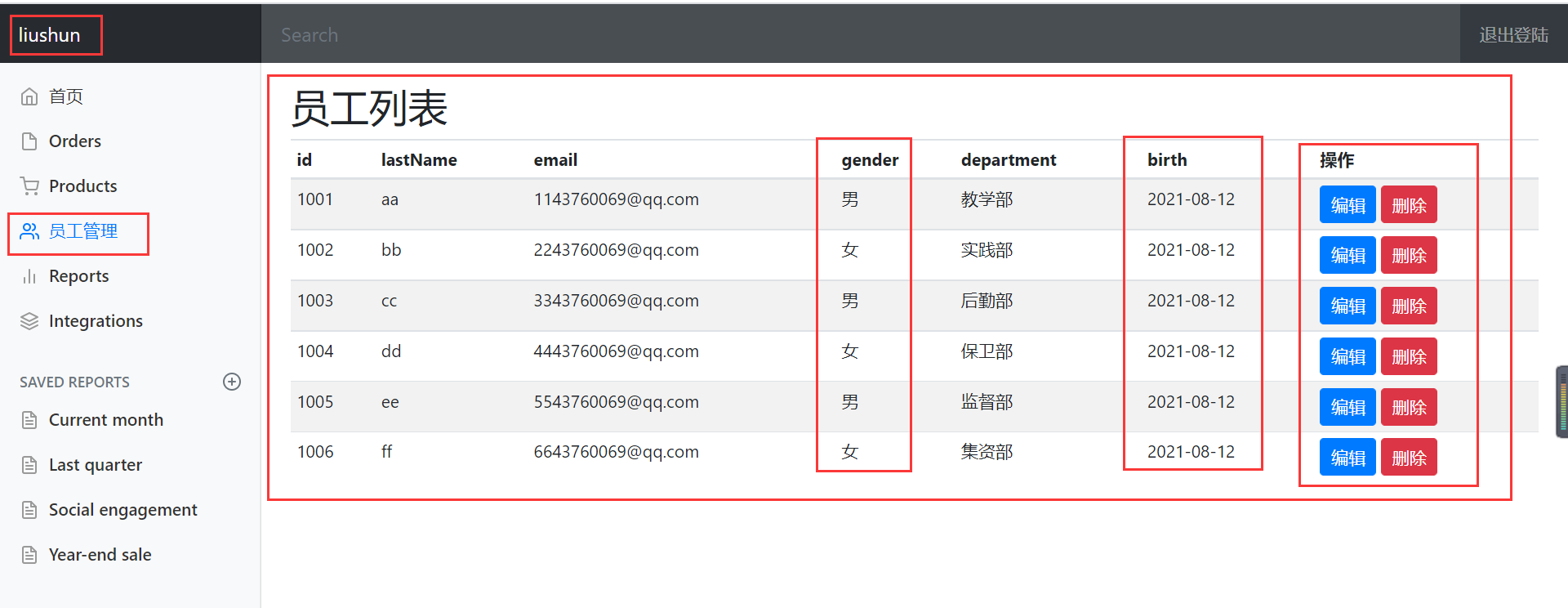
7、添加员工
前端
前端需要一个添加页面add.html
list.html页面中的button组件
<h2><a class="btn btn-sm btn-success" th:href="@{/emp}">添加员工</a> </h2>
add.html页面的主要逻辑,复制list.html的样式
<form th:action="@{/emp}" th:method="post">
<div class="form-group">
<label>LastName</label>
<input type="text" class="form-control" name="lastName" placeholder="sssss">
</div>
<div class="form-group">
<label>Email</label>
<input type="text" class="form-control" name="email" placeholder="sssss">
</div>
<div class="form-group">
<label>Gender</label>
<br>
<div class="form-check form-check-inline">
<input class="form-check-input" type="radio" name="gender" value="1">
<label class="form-check-label">男</label>
</div>
<div class="form-check form-check-inline">
<input class="form-check-input" type="radio" name="gender" value="0">
<label class="form-check-label">女</label>
</div>
</div>
<div class="form-group">
<label>Department</label>
<!-- 这里提交的应该是一个属性,否则需要封装 -->
<select class="form-control" name="department.id">
<option th:each="dept:${departments}" th:text="${dept.getDepartmentName()}" th:value="${dept.getId()}"></option>
</select>
</div>
<div class="form-group">
<label>Birth</label>
<input type="text" class="form-control" name="birth" placeholder="yyyy/mm/dd">
</div>
<button type="submit" class="btn btn-sm btn-primary">添加</button>
</form>
Controller
@GetMapping("/emp")
public String toAddPage(Model model){
//查出所有部门的信息
Collection<Department> departments = departmentDao.getDepartments();
model.addAttribute("departments", departments);
return "emp/add";
}
@PostMapping("/emp")
public String addEmp(Employee employee){
//添加的操作
employeeDao.add(employee);
return "redirect:/emps";
}
restful风格请求,请求路径相同,但是提交方法不同
结果展示

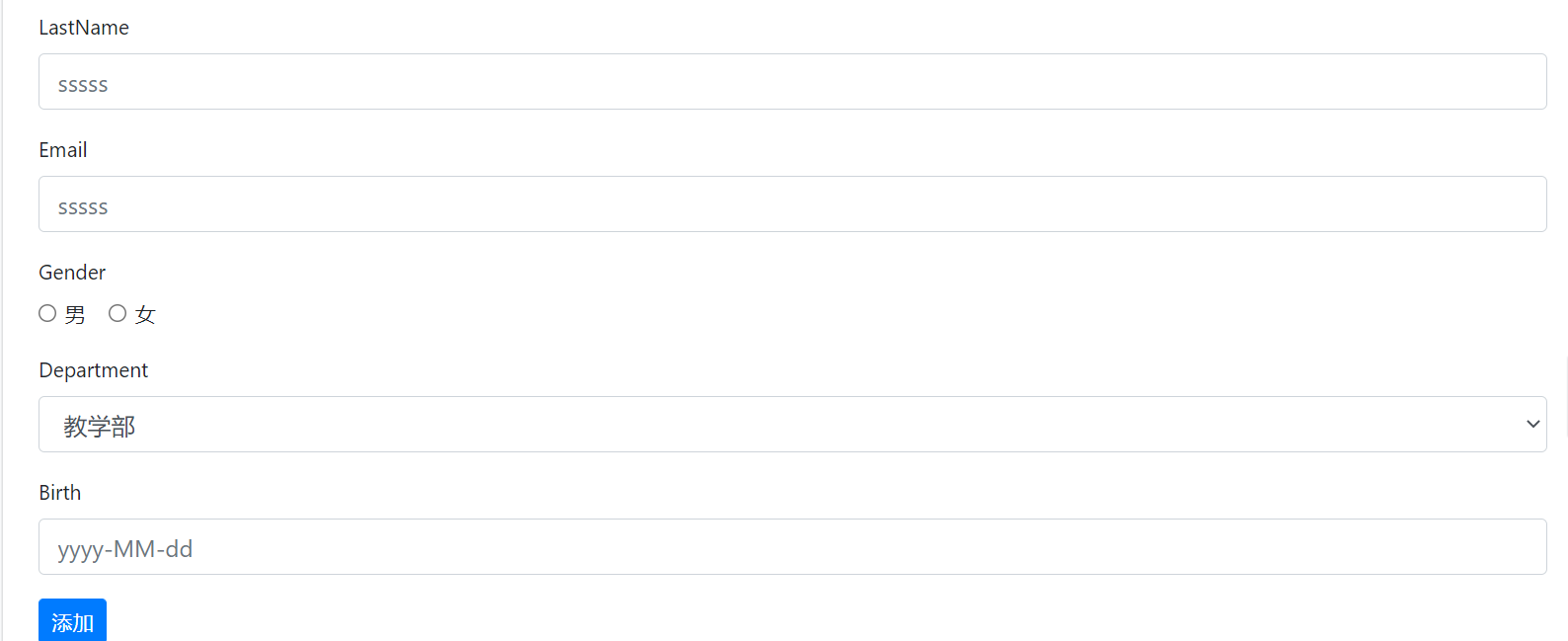
8、修改员工
前端
前端需要一个修改页面,直接复制list.html的样式即可
只不过表单里面需要显示员工原来的信息
<form th:action="@{/updateEmp}" th:method="post">
<input type="hidden" name="id" th:value="${employee.getId()}">
<div class="form-group">
<label>LastName</label>
<input th:value="${employee.getLastName()}" type="text" class="form-control" name="lastName" placeholder="sssss">
</div>
<div class="form-group">
<label>Email</label>
<input th:value="${employee.getEmail()}" type="text" class="form-control" name="email" placeholder="sssss">
</div>
<div class="form-group">
<label>Gender</label>
<br>
<div class="form-check form-check-inline">
<input th:checked="${employee.getGender()==1}" class="form-check-input" type="radio" name="gender" value="1">
<label class="form-check-label">男</label>
</div>
<div class="form-check form-check-inline">
<input th:checked="${employee.getGender()==0}" class="form-check-input" type="radio" name="gender" value="0">
<label class="form-check-label">女</label>
</div>
</div>
<div class="form-group">
<label>Department</label>
<!-- 这里提交的应该是一个属性,否则需要封装 -->
<select class="form-control" name="department.id">
<option th:selected="${dept.getId()==employee.getDepartment().getId()}" th:each="dept:${departments}" th:text="${dept.getDepartmentName()}" th:value="${dept.getId()}"></option>
</select>
</div>
<div class="form-group">
<label>Birth</label>
<input th:value="${#dates.format(employee.getBirth(), 'yyyy-MM-dd')}" type="text" class="form-control" name="birth" placeholder="yyyy-MM-dd">
</div>
<button type="submit" class="btn btn-sm btn-primary">提交修改</button>
</form>
list.html里面的按钮需要修改一下

Controller
需要写一个跳转页面和一个提交修改的页面
同样使用restful风格
@GetMapping("/emp/{id}")
public String toUpdate(@PathVariable("id") Integer id, Model model){
//用户信息
Employee employeeById = employeeDao.getEmployeeById(id);
model.addAttribute("employee", employeeById);
//查出所有部门的信息
Collection<Department> departments = departmentDao.getDepartments();
model.addAttribute("departments", departments);
return "emp/update";
}
@PostMapping("/updateEmp")
public String updateEmp(Employee employee){
employeeDao.add(employee);
return "redirect:/emps";
}
展示
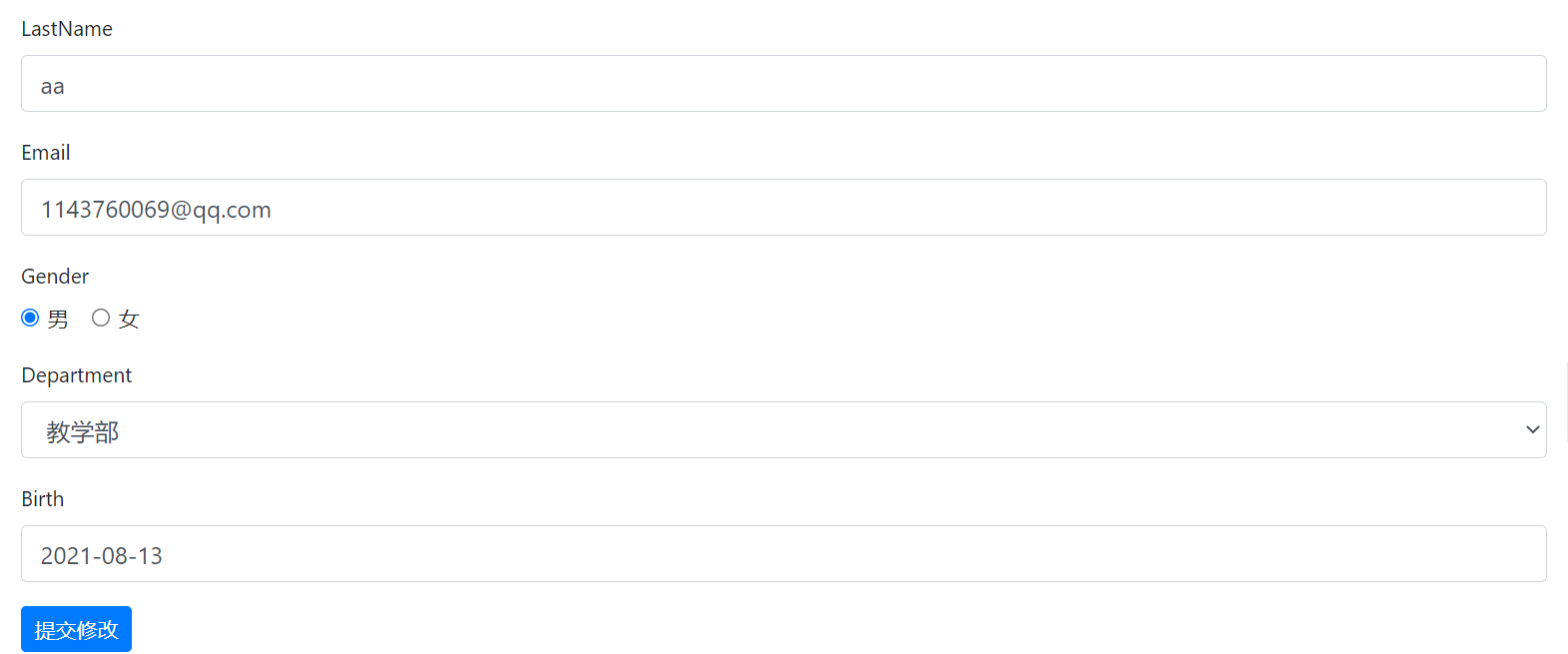
9、删除员工及404的处理
前端按钮提交

后端处理loginController
@RequestMapping("/user/logout")
public String logout(HttpSession session){
session.invalidate();
return "redirect:/index.html";
}
404
在springBoot中,只需要在templates目录下,新修建一个error文件加,见处理错误的代码放在里面,一旦出现错误,就会自动寻找并匹配,比如404.html,500.html等等
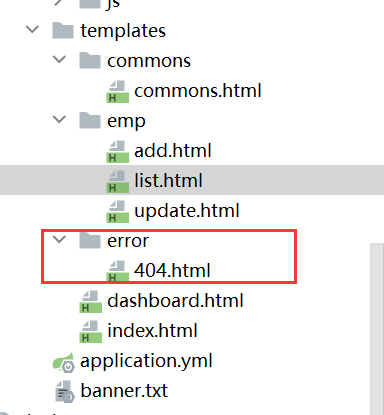
整合JDBC
创建项目时,添加jdbc和mysql driver依赖
配置文件
spring:
datasource:
username: root
password: .20010404liushun
driver-class-name: com.mysql.cj.jdbc.Driver
url: jdbc:mysql://localhost:3306/mybatis?useUnicode=true&characterEncoding=utf-8
Controller使用
使用template可以直接执行
package com.example.datedemo.controller;
import org.springframework.beans.factory.annotation.Autowired;
import org.springframework.jdbc.core.JdbcTemplate;
import org.springframework.web.bind.annotation.GetMapping;
import org.springframework.web.bind.annotation.RestController;
import java.util.List;
import java.util.Map;
@RestController
public class JDBCController {
@Autowired
JdbcTemplate jdbcTemplate;
@GetMapping("/userlist")
public List<Map<String, Object>> userlist(){
String sql = "select * from user";
List<Map<String, Object>> maps = jdbcTemplate.queryForList(sql);
return maps;
}
}
整合Druid数据源
DRUID简介
Druid是阿里巴巴开源平台上一个数据库连接池实现,结合了C3PO、DBCP、PROXOOL等DB池的优点,同时加入了日志监控。
Druid 可以很好的监控DB池连接和SQL的执行情况,天生就是针对监控而生的DB连接池。
Spring Boot 2.0 以上默认使用Hikari 数据源,可以说Hikari与 Driud都是当前Java Web上最优秀的数据源,我们来重点介绍Spring Boot如何集成Druid 数据源,如何实现数据库监控。
com.alibaba.druid.pool.DruidDataSource基本配置参数如下:
| 配置 | 缺省值 | 说明 |
|---|---|---|
| name | 配置这个属性的意义在于,如果存在多个数据源,监控的时候可以通过名字来区分开来。如果没有配置,将会生成一个名字,格式是:"DataSource-" + System.identityHashCode(this). 另外配置此属性至少在1.0.5版本中是不起作用的,强行设置name会出错。详情-点此处。 | |
| url | 连接数据库的url,不同数据库不一样。例如: mysql : jdbc:mysql://10.20.153.104:3306/druid2 oracle : jdbc:oracle:thin:@10.20.149.85:1521:ocnauto | |
| username | 连接数据库的用户名 | |
| password | 连接数据库的密码。如果你不希望密码直接写在配置文件中,可以使用ConfigFilter。详细看这里 | |
| driverClassName | 根据url自动识别 | 这一项可配可不配,如果不配置druid会根据url自动识别dbType,然后选择相应的driverClassName |
| initialSize | 0 | 初始化时建立物理连接的个数。初始化发生在显示调用init方法,或者第一次getConnection时 |
| maxActive | 8 | 最大连接池数量 |
| maxIdle | 8 | 已经不再使用,配置了也没效果 |
| minIdle | 最小连接池数量 | |
| maxWait | 获取连接时最大等待时间,单位毫秒。配置了maxWait之后,缺省启用公平锁,并发效率会有所下降,如果需要可以通过配置useUnfairLock属性为true使用非公平锁。 | |
| poolPreparedStatements | false | 是否缓存preparedStatement,也就是PSCache。PSCache对支持游标的数据库性能提升巨大,比如说oracle。在mysql下建议关闭。 |
| maxPoolPreparedStatement-PerConnectionSize | -1 | 要启用PSCache,必须配置大于0,当大于0时,poolPreparedStatements自动触发修改为true。在Druid中,不会存在Oracle下PSCache占用内存过多的问题,可以把这个数值配置大一些,比如说100 |
| validationQuery | 用来检测连接是否有效的sql,要求是一个查询语句,常用select 'x'。如果validationQuery为null,testOnBorrow、testOnReturn、testWhileIdle都不会起作用。 | |
| validationQueryTimeout | 单位:秒,检测连接是否有效的超时时间。底层调用jdbc Statement对象的void setQueryTimeout(int seconds)方法 | |
| testOnBorrow | true | 申请连接时执行validationQuery检测连接是否有效,做了这个配置会降低性能。 |
| testOnReturn | false | 归还连接时执行validationQuery检测连接是否有效,做了这个配置会降低性能。 |
| testWhileIdle | false | 建议配置为true,不影响性能,并且保证安全性。申请连接的时候检测,如果空闲时间大于timeBetweenEvictionRunsMillis,执行validationQuery检测连接是否有效。 |
| keepAlive | false (1.0.28) | 连接池中的minIdle数量以内的连接,空闲时间超过minEvictableIdleTimeMillis,则会执行keepAlive操作。 |
| timeBetweenEvictionRunsMillis | 1分钟(1.0.14) | 有两个含义: 1) Destroy线程会检测连接的间隔时间,如果连接空闲时间大于等于minEvictableIdleTimeMillis则关闭物理连接。 2) testWhileIdle的判断依据,详细看testWhileIdle属性的说明 |
| numTestsPerEvictionRun | 30分钟(1.0.14) | 不再使用,一个DruidDataSource只支持一个EvictionRun |
| minEvictableIdleTimeMillis | 连接保持空闲而不被驱逐的最小时间 | |
| connectionInitSqls | 物理连接初始化的时候执行的sql | |
| exceptionSorter | 根据dbType自动识别 | 当数据库抛出一些不可恢复的异常时,抛弃连接 |
| filters | 属性类型是字符串,通过别名的方式配置扩展插件,常用的插件有: 监控统计用的filter:stat 日志用的filter:log4j 防御sql注入的filter:wall | |
| proxyFilters | 类型是List<com.alibaba.druid.filter.Filter>,如果同时配置了filters和proxyFilters,是组合关系,并非替换关系 |
druid依赖
<!-- https://mvnrepository.com/artifact/com.alibaba/druid -->
<dependency>
<groupId>com.alibaba</groupId>
<artifactId>druid</artifactId>
<version>1.2.6</version>
</dependency>
配置数据源及相关参数
这些参数一般都是预先设定好的
spring:
datasource:
username: root
password: .20010404liushun
driver-class-name: com.mysql.cj.jdbc.Driver
url: jdbc:mysql://localhost:3306/mybatis?useUnicode=true&characterEncoding=utf-8
type: com.alibaba.druid.pool.DruidDataSource
#Spring Boot 黑认是不注入这些属性值的,需要自己绑定
#druid数据源专有配置
initialSize: 5
minIdle: 5
max-active: 20
max-wait: 60000
time-between-eviction-runs-millis: 60000
min-evictable-idle-time-millis: 300000
validation-query: SELECT 1 FROM DUAL
test-while-idle: true
test-on-borrow: false
test-on-return: false
pool-prepared-statements: true
#配置监控统计拦截的filters, stat:监控统计 Log4j:日志记录 wall:防御lsqL注入
#如果允许时报错java.lang.cLassNotFoundException: org.apache.log4j.Priority
#则导入log4j依赖即可,Maven地址: https : //mvnrepository.com/artifact/log4j/log4j
filters: stat, wall, log4j
maxpoolPreparedStatementPerConnectionSize: 20
useGlobalDataSourceStat: true
connection-properties: druid.stat.mergeSql=true;druid.stat.slowSqlMillis=500
自定义druid配置
这是配置数据库,不是配置我们这个项目
这样配置以后,我们就有了一个对数据库的后台监控了,我们可以通过访问/druid来进入该控制后台,查看相关信息
package com.example.datedemo.config;
import com.alibaba.druid.pool.DruidDataSource;
import com.alibaba.druid.support.http.StatViewServlet;
import com.alibaba.druid.support.http.WebStatFilter;
import org.springframework.boot.context.properties.ConfigurationProperties;
import org.springframework.boot.web.servlet.FilterRegistrationBean;
import org.springframework.boot.web.servlet.ServletRegistrationBean;
import org.springframework.context.annotation.Bean;
import org.springframework.context.annotation.Configuration;
import javax.sql.DataSource;
import java.util.HashMap;
import java.util.logging.Filter;
@Configuration
public class DruidConfig {
@Bean
@ConfigurationProperties(prefix = "spring.datasource")
public DataSource druidDateSource(){
return new DruidDataSource();
}
//后台监控,可以监控数据库操作情况,通过url:/druid可以访问到该后台
//因为SpringBoot内置了servlet容器,所以没有web.xml ,替代方法: ServletRegistrationBean
@Bean
public ServletRegistrationBean StatViewServlet(){
ServletRegistrationBean<StatViewServlet> bean = new ServletRegistrationBean<>(new StatViewServlet(), "/druid/*");
//后台需要有人登录,账号密码配置
HashMap<String, String> initParameters = new HashMap<>();
//增加配置
//登陆的key是固定的,loginUsername loginPassword
initParameters.put("loginUsername", "admin");
initParameters.put("loginPassword", "123456");
//允许谁可以访问 不写就是都可以
initParameters.put("allow", "");
bean.setInitParameters(initParameters);
return bean;
}
//filter
@Bean
public FilterRegistrationBean webStatFilter(){
FilterRegistrationBean bean = new FilterRegistrationBean();
bean.setFilter(new WebStatFilter());
//过滤请求的参数设置
HashMap<String, String> initParameters = new HashMap<>();
//那些请求不进行统计
initParameters.put("exclusions", "*.js,*.css,/druid/*");
bean.setInitParameters(initParameters);
return bean;
}
}
结果展示
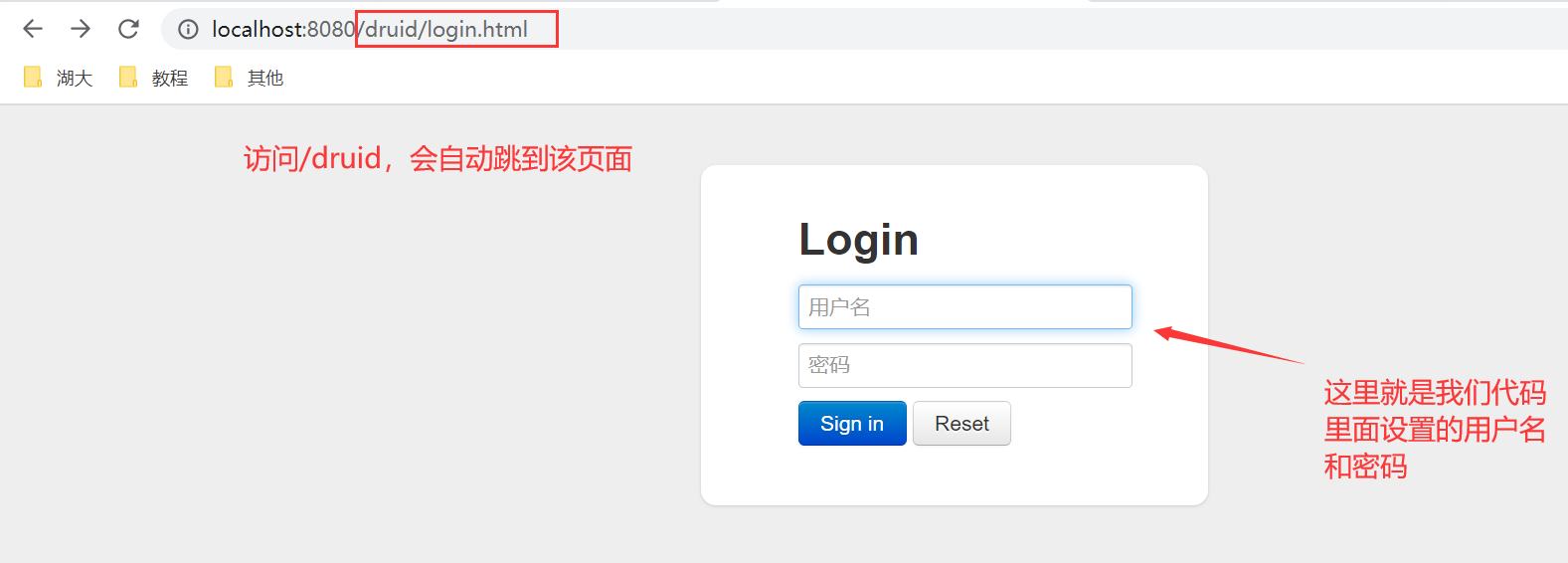
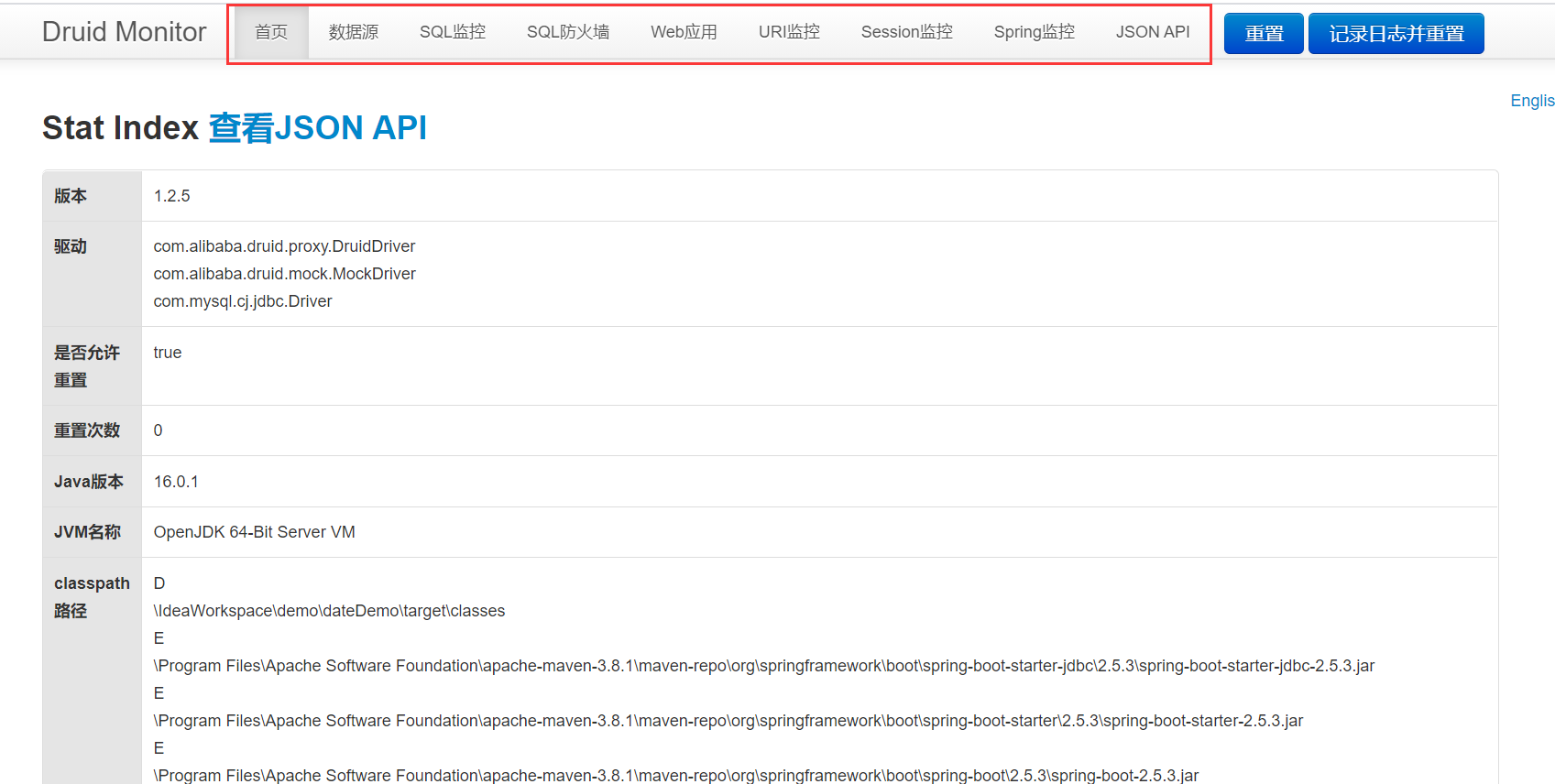
登陆进入后台,就可以看到相关信息
如果执行了一个sql操作,就可以在SQL监控中,看到该语句的执行情况

点进去还可以查看详情
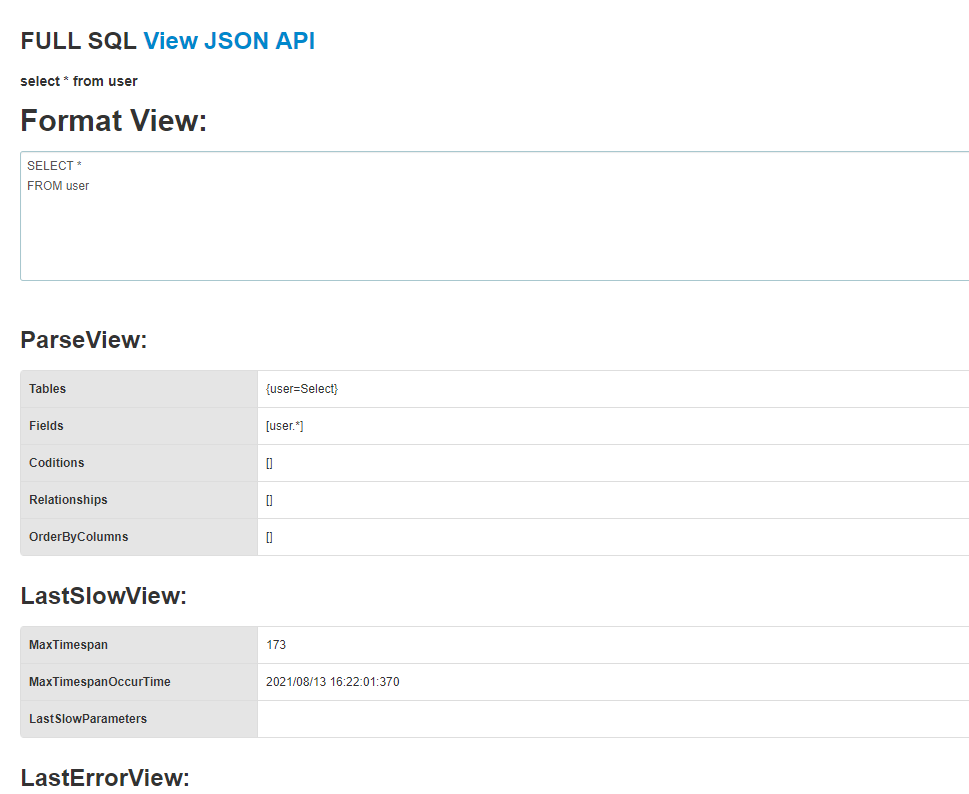
整合MyBatis框架
1、依赖
<!-- https://mvnrepository.com/artifact/org.mybatis.spring.boot/mybatis-spring-boot-starter -->
<dependency>
<groupId>org.mybatis.spring.boot</groupId>
<artifactId>mybatis-spring-boot-starter</artifactId>
<version>2.2.0</version>
</dependency>
2、Mapper接口
直接一个Mapper注解就相当于将mapper注册了
package com.example.mybatisdemo.mapper;
import com.example.mybatisdemo.pojo.User;
import org.apache.ibatis.annotations.Mapper;
import org.springframework.stereotype.Repository;
import java.util.List;
//这个注解表示了这是Mybaits的一个mapper类
@Mapper
@Repository
public interface UserMapper {
List<User> queryUserList();
}
3、配置文件
包括向spring boot里面整合mybatis

4、mapper.xml实现
<?xml version="1.0" encoding="UTF-8"?>
<!DOCTYPE mapper PUBLIC "-//mybatis.org//DTD Mapper 3.0//EN"
"http://mybatis.org/dtd/mybatis-3-mapper.dtd">
<mapper namespace="com.example.mybatisdemo.mapper.UserMapper">
<select id="queryUserList" resultType="User">
select * from user
</select>
</mapper>
5、Controller直接测试
本来需要controller调用service层,然后service层调用mapper(dao)层
package com.example.mybatisdemo.controller;
import com.example.mybatisdemo.mapper.UserMapper;
import com.example.mybatisdemo.pojo.User;
import org.springframework.beans.factory.annotation.Autowired;
import org.springframework.web.bind.annotation.RequestMapping;
import org.springframework.web.bind.annotation.RestController;
import java.util.List;
@RestController
public class UserController {
@Autowired
private UserMapper userMapper;
@RequestMapping("/query")
public List<User> queryUserList(){
List<User> users = userMapper.queryUserList();
for (User user : users) {
System.out.println(user);
}
return users;
}
}
6、结果

SpringSecurity
简介
Spring Security 是针对Spring项目的安全框架,也是Spring Boot底层安全模块默认的技术选型,他可以实现强大的Web安全控制,对于安全控制,我们仅需要引入spring-boot-starter-security模块,进行少量的配置,即可实现强大的安全管理!
记住几个类:
- webSecurityConfigurerAdapter:自定义Security策略
- AuthenticationManagerBuilder:自定义认证策略
- @EnableWebSecurity:开启WebSecurity模式
spring Security的两个主要目标是“认证"和“授权”(访问控制)。
“认证”(Authentication)
“授权”(Authorization)
这个概念是通用的,而不是只在Spring Security中存在。
官网:https://spring.io/projects/spring-security
导入依赖
<dependency>
<groupId>org.springframework.boot</groupId>
<artifactId>spring-boot-starter-security</artifactId>
</dependency>
接下来就只需要在配置文件目录建立配置类即可
用户认证和授权
配置类
重写了授权方法后,访问特定页面需要登陆对应的用户才能访问,对应的用户信息在认证方法中填写(一般是从数据库中获取)
package com.example.mybatisdemo.config;
import org.springframework.security.config.annotation.authentication.builders.AuthenticationManagerBuilder;
import org.springframework.security.config.annotation.web.builders.HttpSecurity;
import org.springframework.security.config.annotation.web.configuration.EnableWebSecurity;
import org.springframework.security.config.annotation.web.configuration.WebSecurityConfigurerAdapter;
import org.springframework.security.crypto.bcrypt.BCryptPasswordEncoder;
//AOP 拦截器 横切
@EnableWebSecurity
public class SecurityConfig extends WebSecurityConfigurerAdapter {
//链式编程
//授权
@Override
protected void configure(HttpSecurity http) throws Exception {
//首页所有人可以访问,功能页只有对应权限的人才能访问
//请求授权的规则
http.authorizeRequests()
.antMatchers("/").permitAll()
.antMatchers("/level1/**").hasRole("vip1")
.antMatchers("/level2/**").hasRole("vip2")
.antMatchers("/level3/**").hasRole("vip3");
//没有权限自动到登录页
http.formLogin();
}
//认证
@Override
protected void configure(AuthenticationManagerBuilder auth) throws Exception {
//这些数据正常应该从数据库中去读
//通过and链接多个用户, passwordEncoder是设置密码加密编码,不加会报错
auth.inMemoryAuthentication().passwordEncoder(new BCryptPasswordEncoder())
.withUser("liushun").password(new BCryptPasswordEncoder().encode("123456")).roles("vip1","vip2")
.and()
.withUser("root").password(new BCryptPasswordEncoder().encode("123456")).roles("vip1","vip2","vip3")
.and()
.withUser("guest").password(new BCryptPasswordEncoder().encode("123456")).roles("vip3");
}
}
数据库中获取认证信息
需要先注入数据源,然后在认证时,获取数据源
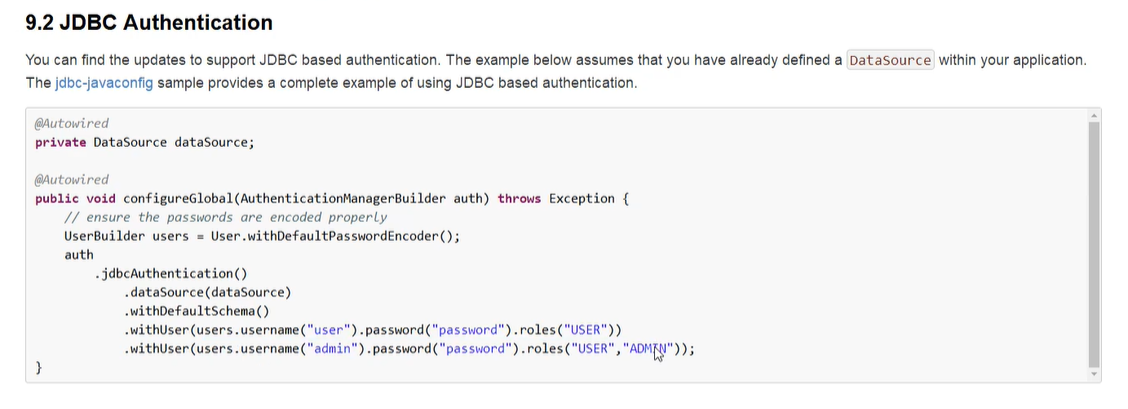
结果及解释
formLogin的方法源码注释中写名了,如果没有登陆就会自动跳转到/login请求,如果认证失败了,会重定向到error请求

登陆页面如下,这个登陆页面是他自己内定配置的,不是我们写的登陆页面

如果账号或者密码错误,会跳转到?error请求,页面如下

登陆成功了,就能访问配置类代码中授权的页面
注销
前端

后端

直接在授权的方法中,假如该语句即可
结果

点击注销即可跳至如下页面,需要确认退出

其余配置-有错
//没有权限自动到登录页, 后面可以设置跳转至哪个页面
http.formLogin().loginPage("/toLogin").usernameParameter("username").passwordParameter("password").loginProcessingUrl("/login");
//注销功能,如果注销成功,返回首页
http.logout().logoutSuccessUrl("/");
//开启记住我功能 cookie默认保存两周
http.rememberMe().rememberMeParameter("remember");
Shiro
简介
Apache Shiro是一个强大且易用的Java安全框架,执行身份验证、授权、密码和会话管理。使用Shiro的易于理解的API,您可以快速、轻松地获得任何应用程序,从最小的移动应用程序到最大的网络和企业应用程序。
主要功能
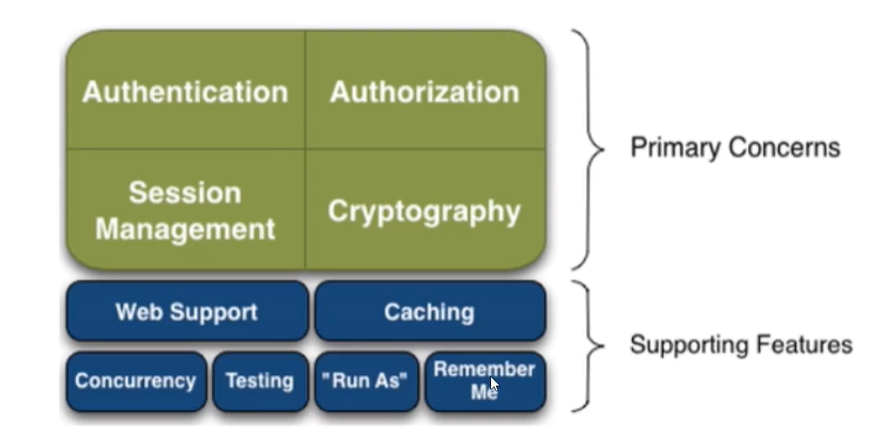
三个核心组件:Subject, SecurityManager 和 Realms.
Subject:即“当前操作用户”。但是,在Shiro中,Subject这一概念并不仅仅指人,也可以是第三方进程、后台帐户(Daemon Account)或其他类似事物。它仅仅意味着“当前跟软件交互的东西”。
Subject代表了当前用户的安全操作,SecurityManager则管理所有用户的安全操作。
SecurityManager:它是Shiro框架的核心,典型的Facade模式,Shiro通过SecurityManager来管理内部组件实例,并通过它来提供安全管理的各种服务。
Realm: Realm充当了Shiro与应用安全数据间的“桥梁”或者“连接器”。也就是说,当对用户执行认证(登录)和授权(访问控制)验证时,Shiro会从应用配置的Realm中查找用户及其权限信息。
从这个意义上讲,Realm实质上是一个安全相关的DAO:它封装了数据源的连接细节,并在需要时将相关数据提供给Shiro。当配置Shiro时,你必须至少指定一个Realm,用于认证和(或)授权。配置多个Realm是可以的,但是至少需要一个。
Shiro内置了可以连接大量安全数据源(又名目录)的Realm,如LDAP、关系数据库(JDBC)、类似INI的文本配置资源以及属性文件等。如果系统默认的Realm不能满足需求,你还可以插入代表自定义数据源的自己的Realm实现。
环境整合
1、首先需要自定义realm类
package com.example.shirodemo.config;
import org.apache.shiro.authc.AuthenticationException;
import org.apache.shiro.authc.AuthenticationInfo;
import org.apache.shiro.authc.AuthenticationToken;
import org.apache.shiro.authz.AuthorizationInfo;
import org.apache.shiro.realm.AuthorizingRealm;
import org.apache.shiro.subject.PrincipalCollection;
public class UserRealm extends AuthorizingRealm {
//授权
@Override
protected AuthorizationInfo doGetAuthorizationInfo(PrincipalCollection principalCollection) {
System.out.println("授权");
return null;
}
//认证
@Override
protected AuthenticationInfo doGetAuthenticationInfo(AuthenticationToken authenticationToken) throws AuthenticationException {
System.out.println("认证");
return null;
}
}
2、然后是配置类
package com.example.shirodemo.config;
import org.apache.shiro.spring.web.ShiroFilterFactoryBean;
import org.apache.shiro.web.mgt.DefaultWebSecurityManager;
import org.springframework.beans.factory.annotation.Qualifier;
import org.springframework.context.annotation.Bean;
import org.springframework.context.annotation.Configuration;
@Configuration
public class ShiroConfig {
//ShiroFilterFactory
@Bean
public ShiroFilterFactoryBean shiroFilterFactoryBean(DefaultWebSecurityManager defaultWebSecurityManager){
ShiroFilterFactoryBean bean = new ShiroFilterFactoryBean();
//设置安全管理器
bean.setSecurityManager(defaultWebSecurityManager);
return bean;
}
//DefaultWebSecurityManager : 2
//根据方法名自动注入
@Bean
public DefaultWebSecurityManager defaultWebSecurityManager(@Qualifier("userRealm") UserRealm userRealm){
DefaultWebSecurityManager defaultWebSecurityManager = new DefaultWebSecurityManager();
//关联realm
defaultWebSecurityManager.setRealm(userRealm);
return defaultWebSecurityManager;
}
//realm 需要自定义类: 1
@Bean
public UserRealm userRealm(){
return new UserRealm();
}
}
登录拦截
只需要在shiroFilterFactoryBean方法中,设置相关属性即可
/* 添加Shiro的内置过滤器
anon:无需认证就可以访问
authc:必颈认证了才能让问
user:必须拥有记住我功能才能用
perms :拥有对某个资源的权限才能访问;
roles :拥有某个角色权限才能访问
*/
Map<String, String> linkedHashMap = new LinkedHashMap<>();
//linkedHashMap.put("/user/add", "anon");
linkedHashMap.put("/user/*", "authc");
bean.setFilterChainDefinitionMap(linkedHashMap);
设置登陆的请求
bean.setLoginUrl("/toLogin");
下面是一些权限等级
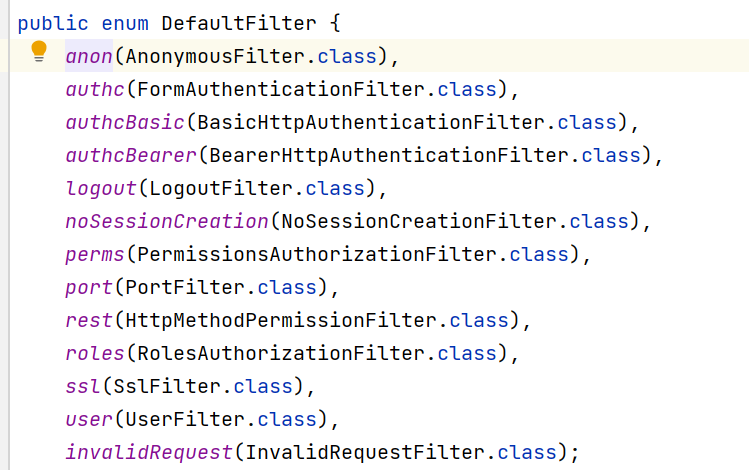
只要点击页面就回跳至登陆页面
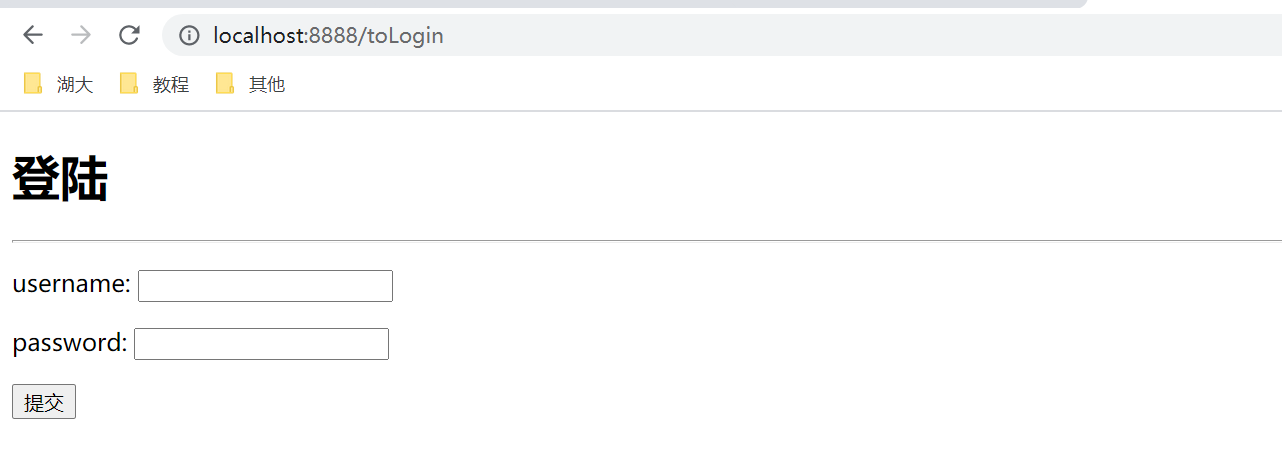 用户验证
用户验证
controller登陆方法
@RequestMapping("/login")
public String login(String username, String password, Model model){
//获取当前用户
Subject subject = SecurityUtils.getSubject();
//封装用户的登陆数据
UsernamePasswordToken token = new UsernamePasswordToken(username, password);
//执行登陆方法,如果没有异常就ok
try{
subject.login(token); //c
return "index";
}catch (UnknownAccountException e){ //用户名
model.addAttribute("msg", "username error");
return "login";
}catch (IncorrectCredentialsException e){ //密码
model.addAttribute("msg", "password error");
return "login";
}
关于认证的一些函数以及用法
subject currentuser = securityutils.getsubject;
session session = currentuser.getsession();
currentuser.isAuthenticated();
currentuser.getPrincipal();
currentUser.hasRole( "schwartz");
currentuser.isPermitted ("lightsaberlwield");
currentuser.logout();
UserRealm中认证方法
//认证
@Override
protected AuthenticationInfo doGetAuthenticationInfo(AuthenticationToken authenticationToken) throws AuthenticationException {
System.out.println("认证");
//从数据库中获取
String username = "root";
String password = "123456";
UsernamePasswordToken usernamePasswordToken = (UsernamePasswordToken) authenticationToken;
if(!usernamePasswordToken.getUsername().equals(username)){
return null;//抛出异常
}
//密码验证,shiro做,这是为了安全,防止泄露
return new SimpleAuthenticationInfo("", password, "");
}
结果
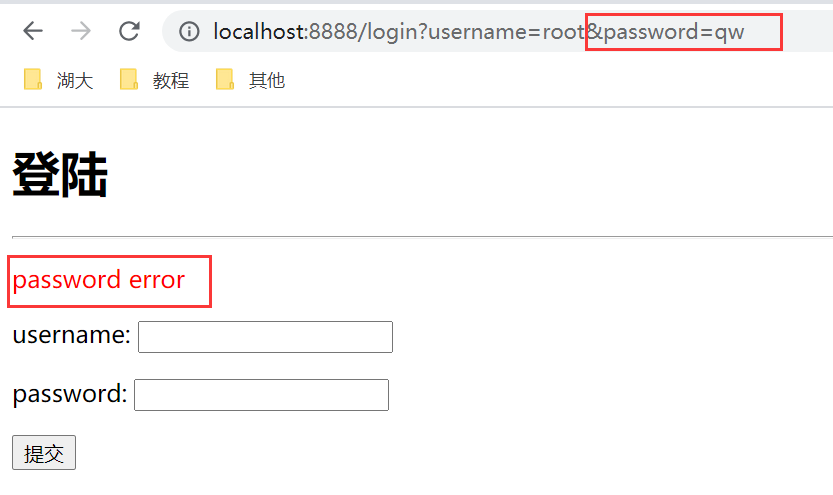
输入错误密码,会提示密码错误,同样用户名也如此,只有登陆成功了,就能够访问add和update页面
整合mybatis-数据库
依赖
<dependency>
<groupId>mysql</groupId>
<artifactId>mysql-connector-java</artifactId>
</dependency>
<dependency>
<groupId>log4j</groupId>
<artifactId>log4j</artifactId>
<version>1.2.17</version>
</dependency>
<dependency>
<groupId>com.alibaba</groupId>
<artifactId>druid</artifactId>
<version>1.2.6</version>
</dependency>
<dependency>
<groupId>org.mybatis.spring.boot</groupId>
<artifactId>mybatis-spring-boot-starter</artifactId>
<version>2.2.0</version>
</dependency>
建立mapper,service,pojo层
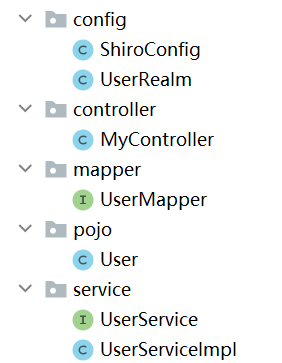
resources里面需要添加xml配置文件

yml文件配置数据源,以及mybatis
server:
port: 8888
spring:
datasource:
username: root
password: .20010404liushun
driver-class-name: com.mysql.cj.jdbc.Driver
url: jdbc:mysql://localhost:3306/mybatis?useUnicode=true&characterEncoding=utf-8
type: com.alibaba.druid.pool.DruidDataSource
#Spring Boot 黑认是不注入这些属性值的,需要自己绑定
#druid数据源专有配置
initialSize: 5
minIdle: 5
max-active: 20
max-wait: 60000
time-between-eviction-runs-millis: 60000
min-evictable-idle-time-millis: 300000
validation-query: SELECT 1 FROM DUAL
test-while-idle: true
test-on-borrow: false
test-on-return: false
pool-prepared-statements: true
#配置监控统计拦截的filters, stat:监控统计 Log4j:日志记录 wall:防御lsqL注入
#如果允许时报错java.lang.cLassNotFoundException: org.apache.log4j.Priority
#则导入log4j依赖即可,Maven地址: https : //mvnrepository.com/artifact/log4j/log4j
filters: stat, wall, log4j
maxpoolPreparedStatementPerConnectionSize: 20
useGlobalDataSourceStat: true
connection-properties: druid.stat.mergeSql=true;druid.stat.slowSqlMillis=500
mybatis:
type-aliases-package: com.example.shirodemo.pojo
mapper-locations: classpath:mapper/*.xml
realm类方法实现数据库
public class UserRealm extends AuthorizingRealm {
//为了从数据库中获得数据
@Autowired
UserServiceImpl userService;
//认证
@Override
protected AuthenticationInfo doGetAuthenticationInfo(AuthenticationToken authenticationToken) throws AuthenticationException {
System.out.println("认证");
UsernamePasswordToken usernamePasswordToken = (UsernamePasswordToken) authenticationToken;
//从数据库中获得数据
User user = userService.queryUserByName(((UsernamePasswordToken) authenticationToken).getUsername());
if (user == null){
return null;
}
//密码验证,shiro做 加密了
return new SimpleAuthenticationInfo("", user.getPassword(), "");
}
}
请求授权
1、shiroFilterFactoryBean方法
LinkedHashMap<String, String> linkedHashMap = new LinkedHashMap<>();
// ----授权一定要卸载拦截前面---
//授权
//如果没有被授权,就会跳转到未授权页面
linkedHashMap.put("/user/add", "perms[user:add]");
linkedHashMap.put("/user/update", "perms[user:update]");
//拦截
//这里拦截的是url请求,所以需要和requestMapping的路径一致
//linkedHashMap.put("/user/add", "anon");
linkedHashMap.put("/user/*", "authc");
bean.setFilterChainDefinitionMap(linkedHashMap);
//设置登陆的请求
bean.setLoginUrl("/toLogin");
//设置未授权页面
bean.setUnauthorizedUrl("/unauth");
2、doGetAuthorizationInfo方法
授权操作
//授权
@Override
protected AuthorizationInfo doGetAuthorizationInfo(PrincipalCollection principalCollection) {
System.out.println("授权");
//给用户授予权限,拿到授权对象
SimpleAuthorizationInfo info = new SimpleAuthorizationInfo();
//拿到当前对象
Subject subject = SecurityUtils.getSubject();
//拿到user对象,通过认证方法的返回值
User currentUser = (User) subject.getPrincipal();
//设置当前用户的权限
info.addStringPermission(currentUser.getPerms());
return info;
}
user对象由认证方法获得
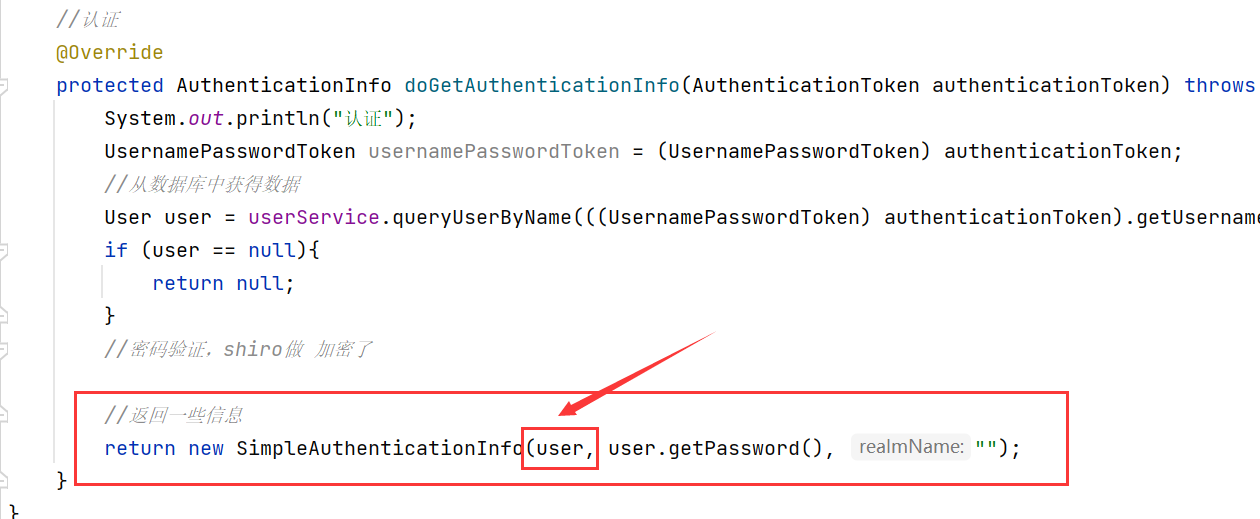
3、Controller需要处理没有权限请求
@RequestMapping("/unauth")
@ResponseBody
public String unauthorized(){
return "未经授权无法访问该页面";
}
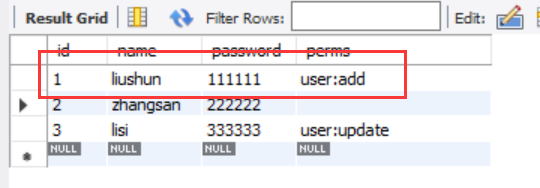
这样,登陆liushun用户后,他只能访问add页面,不能访问update页面
整合thymeleaf
maven依赖
<!--整合shiro和thymeleaf-->
<dependency>
<groupId>com.github.theborakompanioni</groupId>
<artifactId>thymeleaf-extras-shiro</artifactId>
<version>2.0.0</version>
</dependency>
前端页面控制
主要实现的功能就是,有哪些权限就显示哪些页面,以及登陆成功后就不显示登陆按钮了
<h1>首页</h1>
<div th:if="${session.loginUser==null}">
<a th:href="@{/toLogin}">登陆</a>
</div>
<p th:text="${msg}"></p>
<hr>
<div shiro:hasPermission="user:add">
<a th:href="@{/user/add}">add</a>
</div>
<div shiro:hasPermission="user:update">
<a th:href="@{/user/update}">update</a>
</div>
设置session信息--UserRealm的认证方法中
这个session不是网站的session,这是Java中的一个接口
//还可以设置session,并且在前端获取
Subject subject = SecurityUtils.getSubject();
Session session = subject.getSession();
session.setAttribute("loginUser", user);
存在问题
在项目中使用shiro作为权限控制,配置成功后,访问一切正常。但发现在向登录页面重定向时,URL中总是带;JSESSIONID=***,这时Session的另一种使用方式(一种是Cookie)。
导致出现400错误
解决方案
实现一个DefaultWebSessionManager类,将他的自动追加功能设置为false
//解决整合thymeleaf url自动追加sessionid的问题
@Bean
public DefaultWebSessionManager defaultWebSessionManager(){
DefaultWebSessionManager defaultWebSessionManager = new DefaultWebSessionManager();
//不让重写url
defaultWebSessionManager.setSessionIdUrlRewritingEnabled(false);
return defaultWebSessionManager;
}
//DefaultWebSecurityManager : 2
//根据方法名自动注入
@Bean
public DefaultWebSecurityManager defaultWebSecurityManager(@Qualifier("userRealm") UserRealm userRealm, DefaultWebSessionManager defaultWebSessionManager){
DefaultWebSecurityManager defaultWebSecurityManager = new DefaultWebSecurityManager();
//关联realm
defaultWebSecurityManager.setSessionManager(defaultWebSessionManager);
defaultWebSecurityManager.setRealm(userRealm);
return defaultWebSecurityManager;
}
这样,验证后,并能正确访问了
结果展示
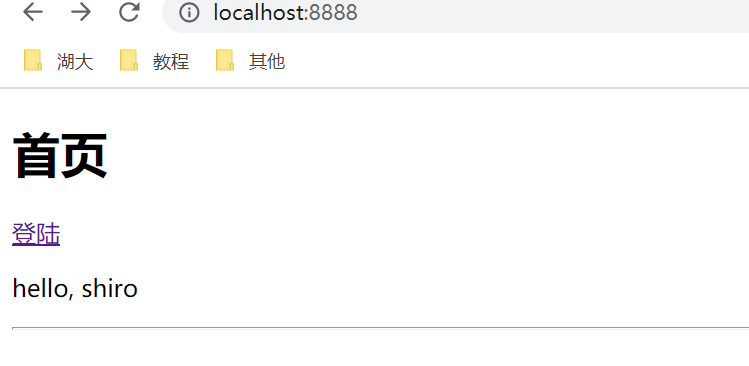
初始,没有用户时,只有一个登录按钮
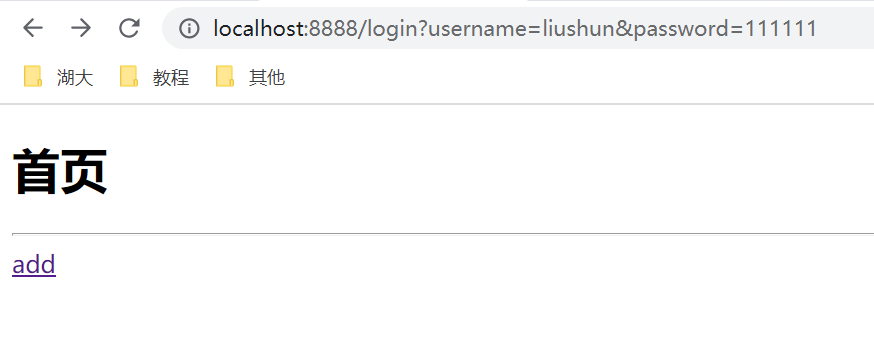
登录用户后,就没有了登录按钮,有了它对应权限相应的页面选项

点击add按钮,也可以看到请求url没有追加sessionId了,可以正常访问
Swagger
学习目标
- 了解Swagger的作用和概念
- 了解前后端分离
- 在SpringBoot中集成Swagger
前后端分离
前后端分离式时代:
- 后端︰后端控制层,服务层,数据访问层【后端团队】
- 前端︰前端控制层,视图层【前端团队】
- 伪造后端数据,json。已经存在了,不需要后端,前端工程依旧能够跑起来
- 前端后如何交互?===>APl
- 前后端相对独立,松耦合;
- 前后端甚至可以部署在不同的服务器上;
简介
- 号称世界上最流行的Api框架;
- RestFul Api文档在线自动生成工具=>Api文档与API定义同步更新
- 直接运行,可以在线测试API接口;
- 支持多种语言:(Java,Php....)
springBoot集成
maven依赖
<!--使用2.9.2版本最好 -->
<!-- https://mvnrepository.com/artifact/io.springfox/springfox-swagger2 -->
<dependency>
<groupId>io.springfox</groupId>
<artifactId>springfox-swagger2</artifactId>
<version>2.9.2</version>
</dependency>
<!-- https://mvnrepository.com/artifact/io.springfox/springfox-swagger-ui -->
<dependency>
<groupId>io.springfox</groupId>
<artifactId>springfox-swagger-ui</artifactId>
<version>2.9.2</version>
</dependency>
需要自己写配置类
package com.example.swaggerdemo.config;
import org.springframework.beans.factory.config.YamlProcessor;
import org.springframework.context.annotation.Bean;
import org.springframework.context.annotation.Configuration;
import org.springframework.web.servlet.config.annotation.ResourceHandlerRegistry;
import org.springframework.web.servlet.config.annotation.WebMvcConfigurationSupport;
import springfox.documentation.service.ApiInfo;
import springfox.documentation.service.Contact;
import springfox.documentation.spi.DocumentationType;
import springfox.documentation.spring.web.plugins.Docket;
import springfox.documentation.swagger2.annotations.EnableSwagger2;
import java.util.ArrayList;
@Configuration
@EnableSwagger2
public class SwaggerConfig extends WebMvcConfigurationSupport {
@Bean
public Docket docket(){
return new Docket(DocumentationType.SWAGGER_2)
.apiInfo(apiInfo());
}
//配置swagger信息
public ApiInfo apiInfo(){
//可以用builder来设置信息,更加清晰
// private ApiInfo apiInfo(){
// return new ApiInfoBuilder()
// .title("Swagger2")
// .description("RESTful API接口")
// .version("1.0.1")
// .build();
// }
Contact contact = new Contact("liushun", "aaa", "1743760060@qq.com");
return new ApiInfo(
"刘顺的swaggerAPI文档",
"努力就好",
"v1.0",
"111",
contact,
"Apache 2.0",
"http://www.apache.org/licenses/LICENSE-2.0",
new ArrayList<>()
);
}
/**
* 解决swagger-ui.html 404无法访问的问题 要用2.9.2版本的maven jar包
*/
@Override
protected void addResourceHandlers(ResourceHandlerRegistry registry) {
// 解决静态资源无法访问
registry.addResourceHandler("/**")
.addResourceLocations("classpath:/static/");
// 解决swagger无法访问
registry.addResourceHandler("/swagger-ui.html")
.addResourceLocations("classpath:/META-INF/resources/");
// 解决swagger的js文件无法访问
registry.addResourceHandler("/webjars/**")
.addResourceLocations("classpath:/META-INF/resources/webjars/");
super.addResourceHandlers(registry);
}
}
初结果
访问swagger-ui.html请求,就可以进入该页面
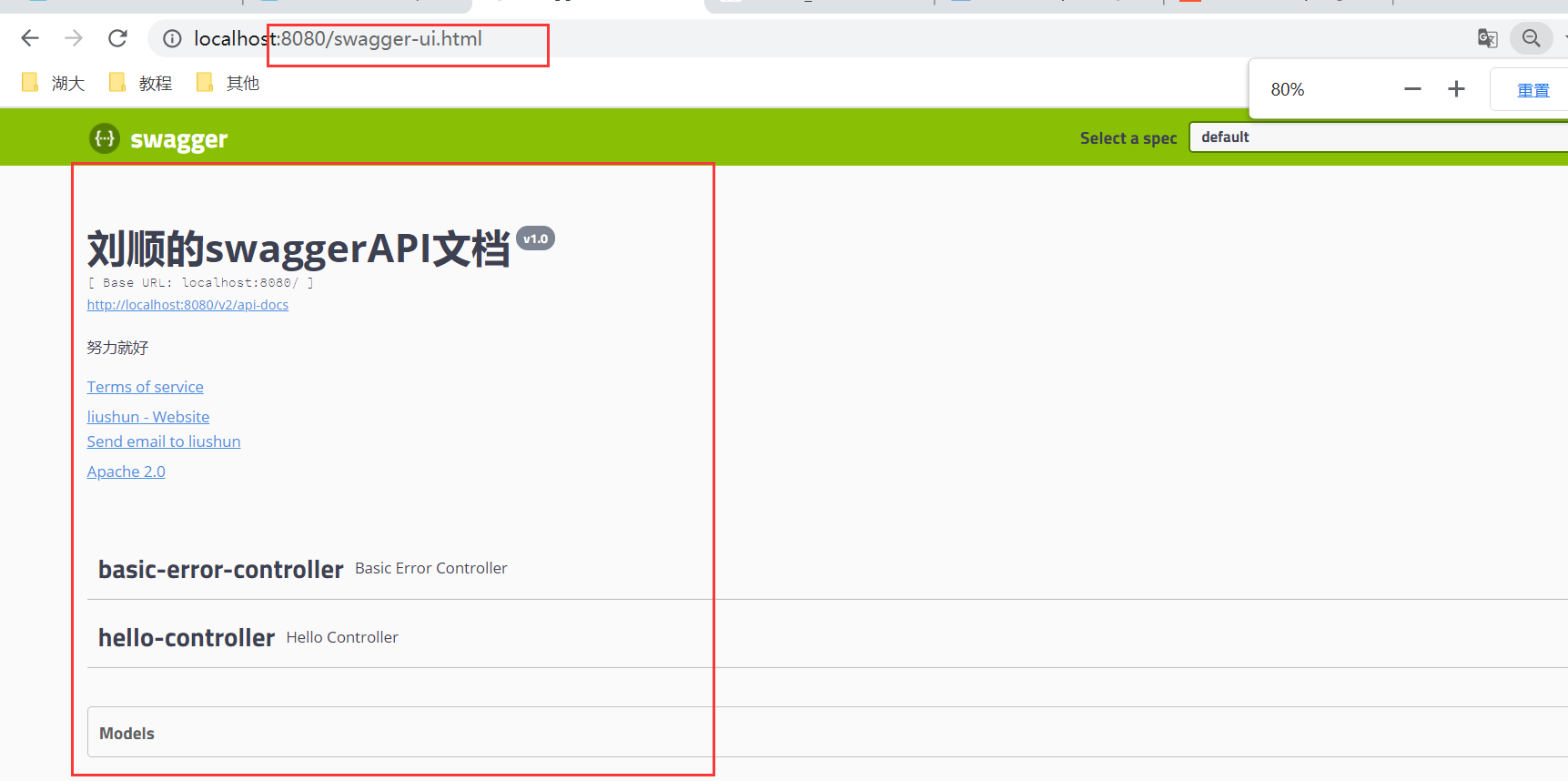
配置扫描接口及开关
@Bean
public Docket docket(Environment environment){
//获得项目的运行环境
Profiles profiles = Profiles.of("dev", "test");
//通过environment.acceptsProfiles判断是否处在设定的环境中
boolean flag = environment.acceptsProfiles(profiles);
return new Docket(DocumentationType.SWAGGER_2)
.apiInfo(apiInfo())
//是否启用swagger,false则不能在浏览器中访问,默认为true
.enable(flag)
//select和build是配套的,中间不能加别的了,只能是apis和paths
.select()
//RequestHandlerSelectors 配置要扫描接口的方式
//basePackage 指定要扫描的包
//any 扫描所有
//none 不扫描
.apis(RequestHandlerSelectors.basePackage("com.example.swaggerdemo.controller"))
//过滤路径 只扫描/user路径下的请求
//.paths(PathSelectors.ant("/user/**"))
.build();
}
配置多套环境,并且可以选择激活哪套环境
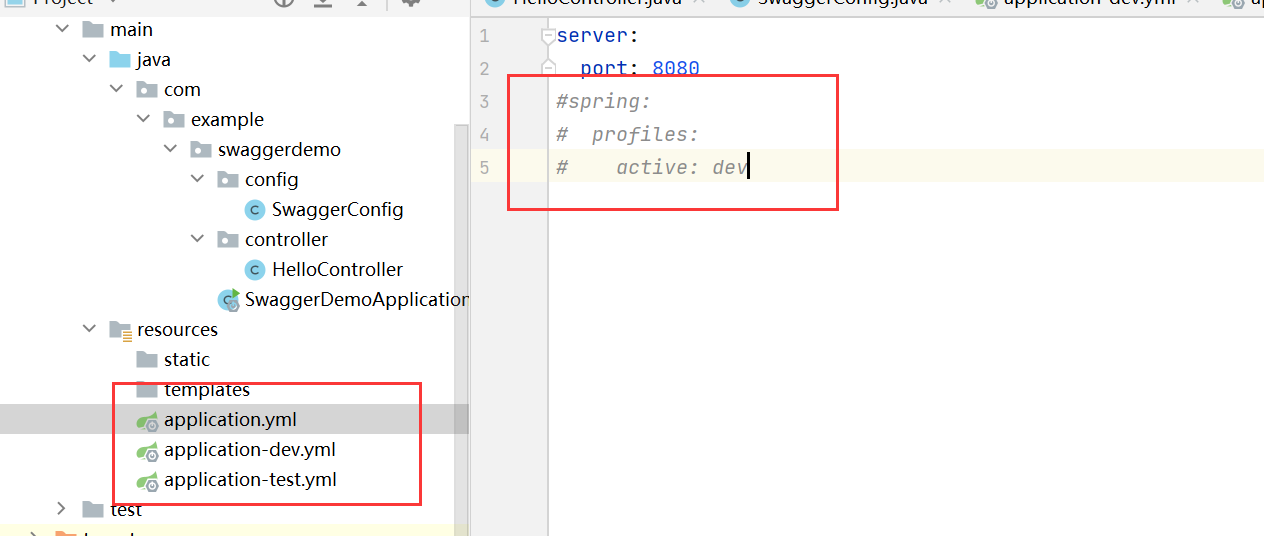
如果选择默认环境,端口为8080,那么,他就不能访问swagger

如果选择dev环境,他就可以授权访问
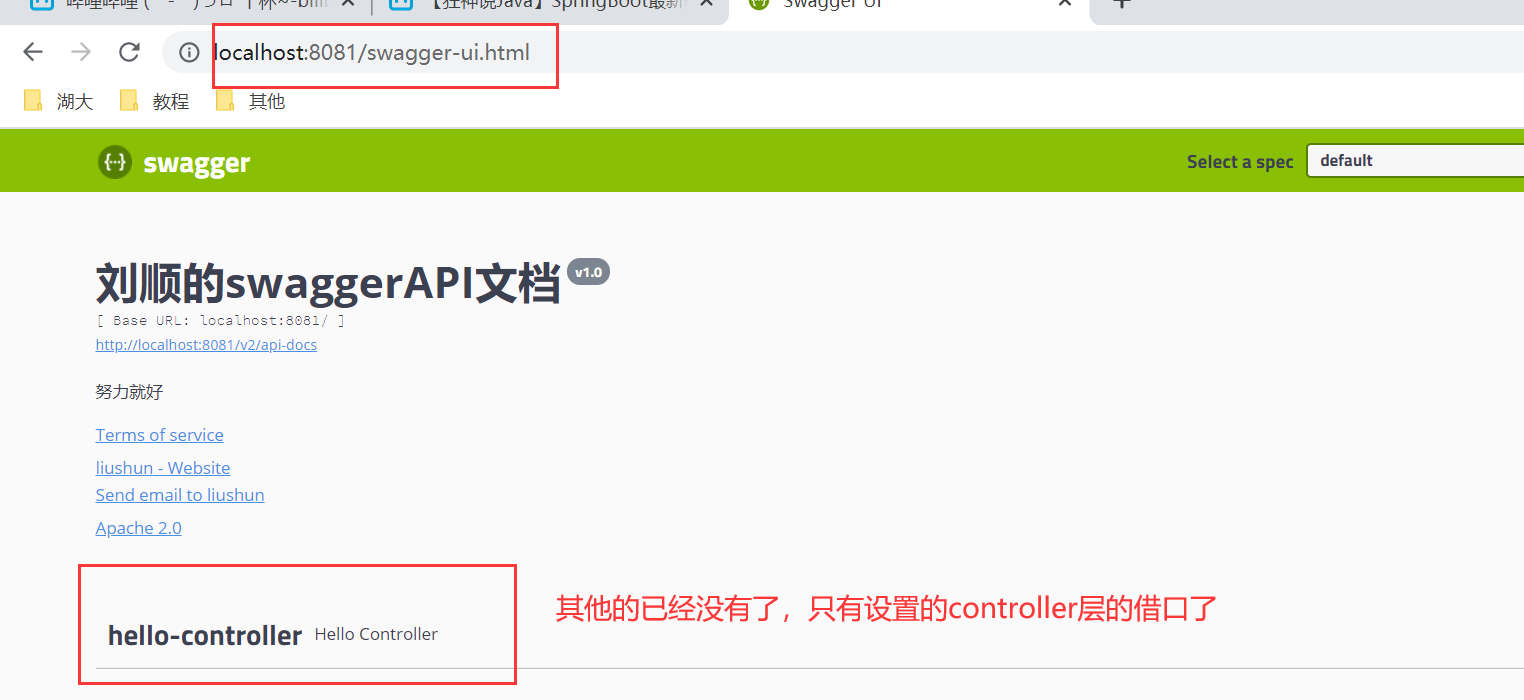
配置API文档的分组
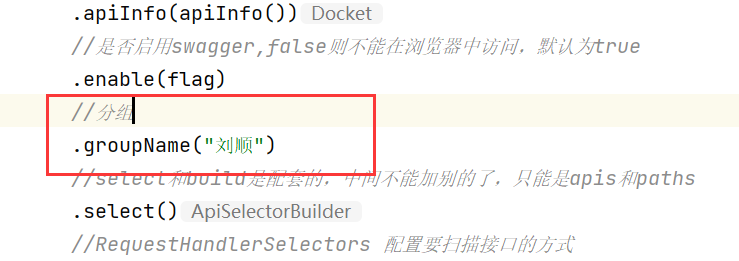
原来默认是default

多用户
//可以配置多个Docket,代表了多个用户
@Bean
public Docket docketA(){
return new Docket(DocumentationType.SWAGGER_2).groupName("A");
}
@Bean
public Docket docketB(){
return new Docket(DocumentationType.SWAGGER_2).groupName("B");
}
@Bean
public Docket docketC(){
return new Docket(DocumentationType.SWAGGER_2).groupName("C");
}
@Bean
public Docket docket(Environment environment){
//获得项目的运行环境
Profiles profiles = Profiles.of("dev", "test");
//通过environment.acceptsProfiles判断是否处在设定的环境中
boolean flag = environment.acceptsProfiles(profiles);
return new Docket(DocumentationType.SWAGGER_2)
.apiInfo(apiInfo())
//是否启用swagger,false则不能在浏览器中访问,默认为true
.enable(flag)
//分组
.groupName("刘顺")
//select和build是配套的,中间不能加别的了,只能是apis和paths
.select()
//RequestHandlerSelectors 配置要扫描接口的方式
//basePackage 指定要扫描的包
//any 扫描所有
//none 不扫描
.apis(RequestHandlerSelectors.basePackage("com.example.swaggerdemo.controller"))
//过滤路径 只扫描/user路径下的请求
//.paths(PathSelectors.ant("/user/**"))
.build();
}
结果如下
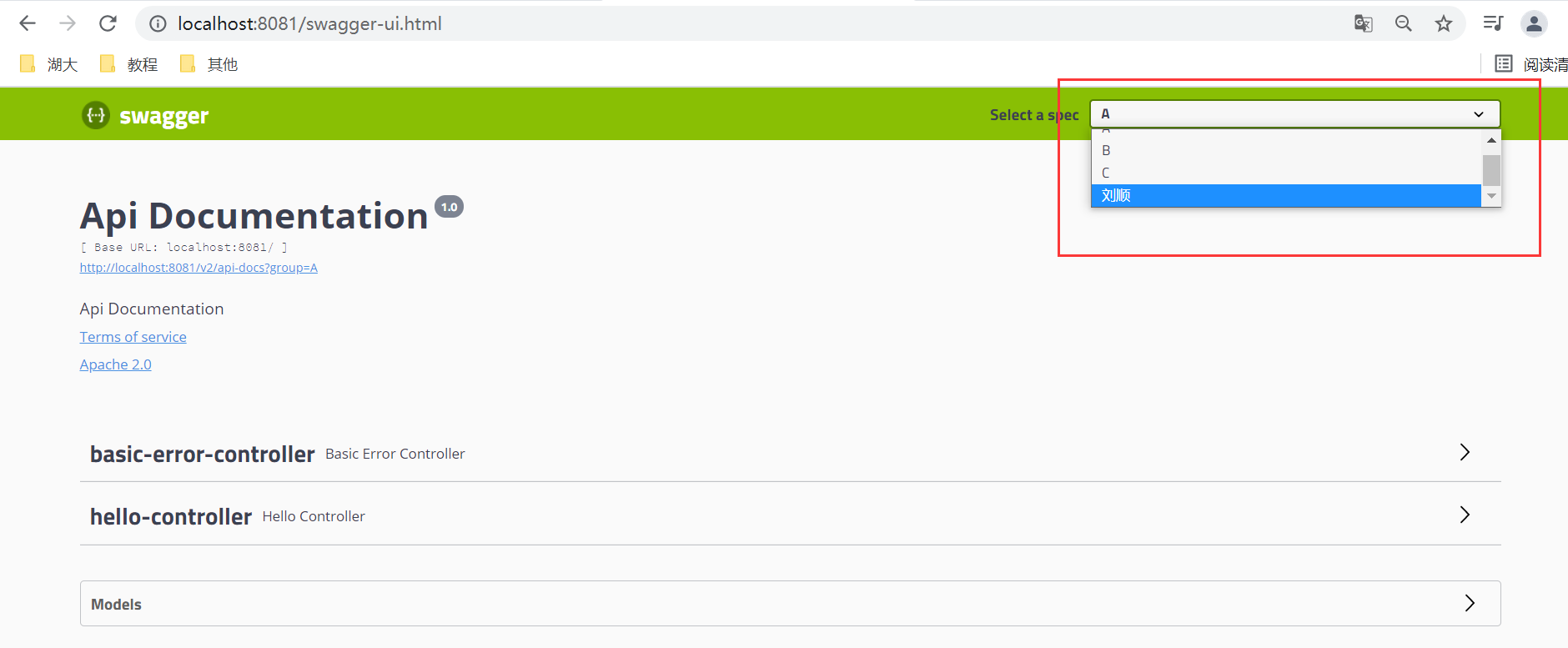
注释
实体类
package com.example.swaggerdemo.pojo;
import io.swagger.annotations.ApiModel;
import io.swagger.annotations.ApiModelProperty;
//@Api(注释)
@ApiModel("用户实体类")
public class User {
@ApiModelProperty("用户名")
public String username;
@ApiModelProperty("密码")
public String password;
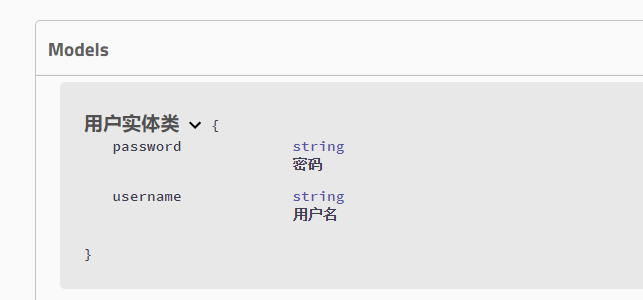
controller
@Api(tags = "hello控制类")
@Controller
public class HelloController {
@ResponseBody
@GetMapping("/hello")
public String hello(){
return "hello";
}
//只要我们的接口中,返回的是一个实体类,就会被扫描到swagger中
@ResponseBody
@PostMapping("/user")
public User user(){
return new User("liushun", "123456");
}
@ApiOperation("hello控制类")
@GetMapping("/hello2")
public String hello2(@ApiParam("用户名") String username){
return "hello" + username;
}
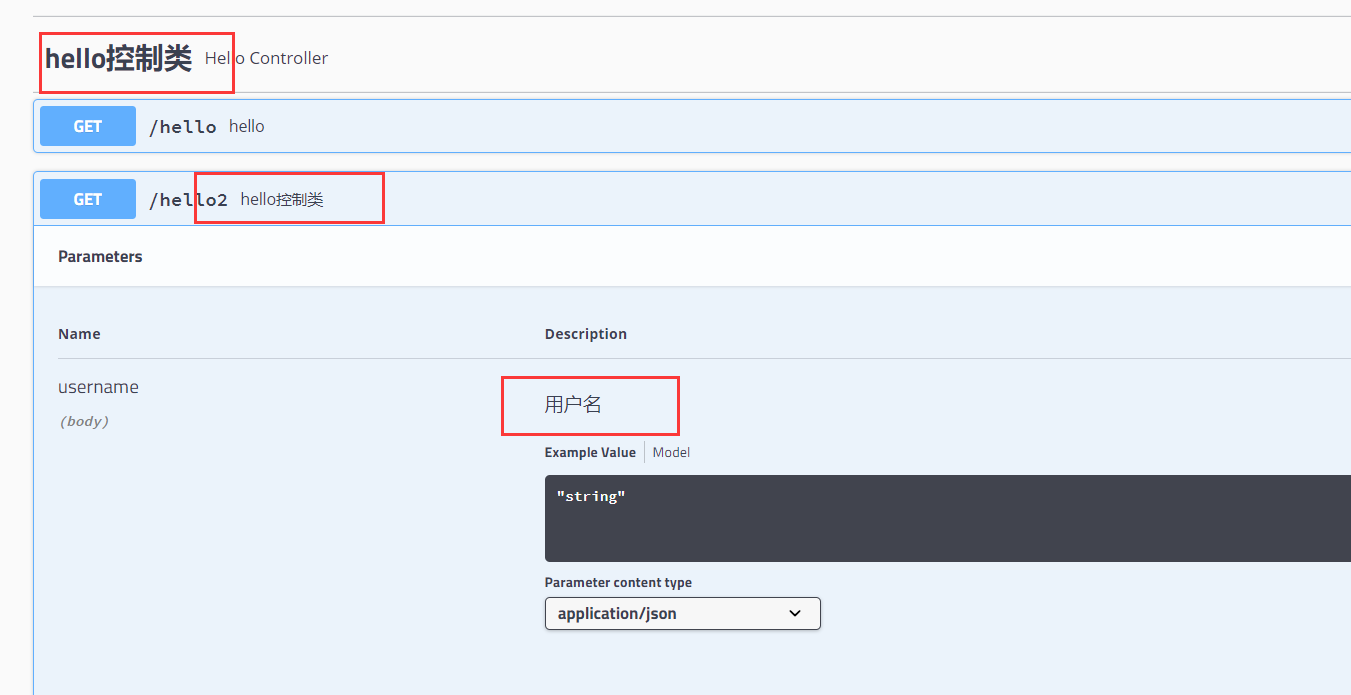
测试
点击try it out,可以进行测试
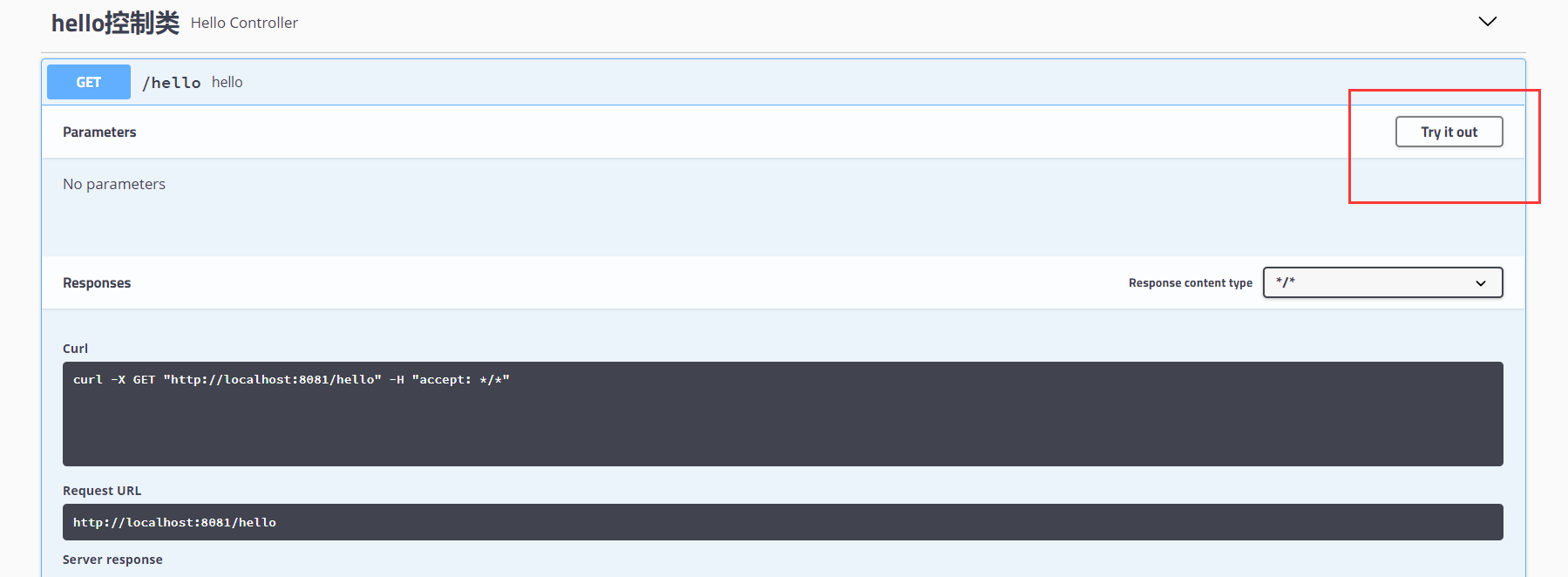
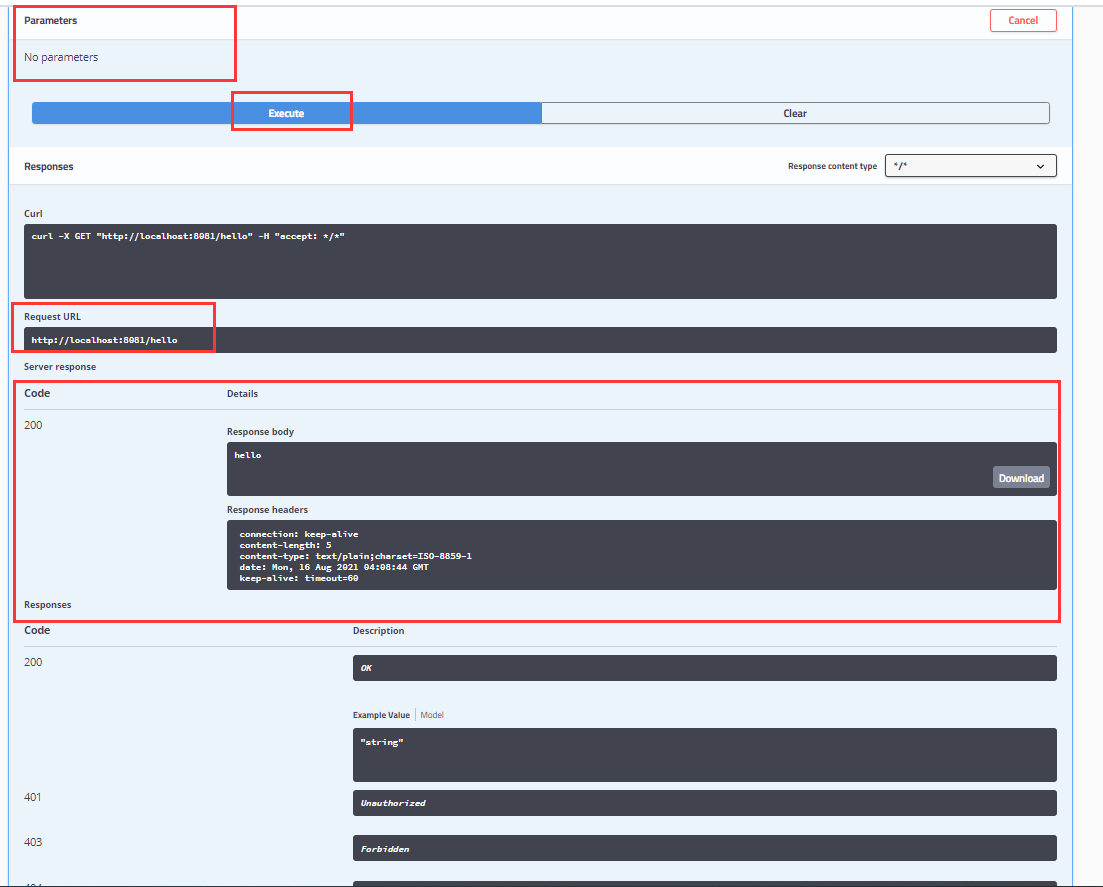
下面就会要你填写参数,点击execute就可以执行请求,就可以看到执行结果及相关信息
总结
- 我们可以通过Swagger给一些比较难理解的属性或者接口,增加注释信息
- 接口文档实时更新
- 可以在线测试
Swagger是一个优秀的工具,几乎所有大公司都有使用它
【注意点】在正式发布的时候,关闭Swagger! ! !出于安全考虑。而且节省运行的内存;
任务
异步任务
有时候一些消耗时间的工作可以开启一个异步任务去处理,提高用户的体验感
只需要在启动类和需要异步执行的方法上加上注解即可实现
启动类
//开启异步功能
@EnableAsync
@SpringBootApplication
public class TaskDemoApplication {
public static void main(String[] args) {
SpringApplication.run(TaskDemoApplication.class, args);
}
}
异步方法
package com.example.taskdemo.service;
import org.springframework.scheduling.annotation.Async;
import org.springframework.stereotype.Service;
@Service
public class AsyncService {
//异步方法
@Async
public void hello(){
try{
Thread.sleep(3000);
}catch (InterruptedException e){
e.printStackTrace();
}
System.out.println("handling.....");
}
}
Controller
@Controller
public class HelloController {
@Autowired
AsyncService asyncService;
@ResponseBody
@RequestMapping("/hello")
public String hello(){
asyncService.hello();
return "hello";
}
}
邮件任务
导入jar包
<dependency>
<groupId>org.springframework.boot</groupId>
<artifactId>spring-boot-starter-mail</artifactId>
</dependency>
配置文件
spring.mail.host=smtp.qq.com
spring.mail.username=1743760069@qq.com
#授权码
spring.mail.password=ansrfoqtefwhbgbb
#开启加密验证
spring.mail.properties.mail.smtp.ssl.enable=true
发送邮件
@SpringBootTest
class TaskDemoApplicationTests {
@Autowired
JavaMailSenderImpl javaMailSender;
@Test
void contextLoads() {
//一个简单的邮件
SimpleMailMessage simpleMailMessage = new SimpleMailMessage();
simpleMailMessage.setSubject("subject");
simpleMailMessage.setText("text");
simpleMailMessage.setFrom("1743760069@qq.com");
simpleMailMessage.setTo("1743760069@qq.com");
javaMailSender.send(simpleMailMessage);
}
@Test
void contextLoads2() throws MessagingException {
//一个复杂的邮件,可以将这个封装为一个方法,就可以作为一个工具类了
MimeMessage mimeMessage = javaMailSender.createMimeMessage();
//组装
MimeMessageHelper helper = new MimeMessageHelper(mimeMessage, true);
helper.setSubject("subject");
helper.setText("<h1 style='color:red'>text</h1>", true);
//附件,第一个参数是自己命名的文件名
helper.addAttachment("1.png", new File("C:\\Users\\17437\\Desktop\\1.png"));
helper.setFrom("1743760069@qq.com");
helper.setTo("1743760069@qq.com");
javaMailSender.send(mimeMessage);
}
}
结果
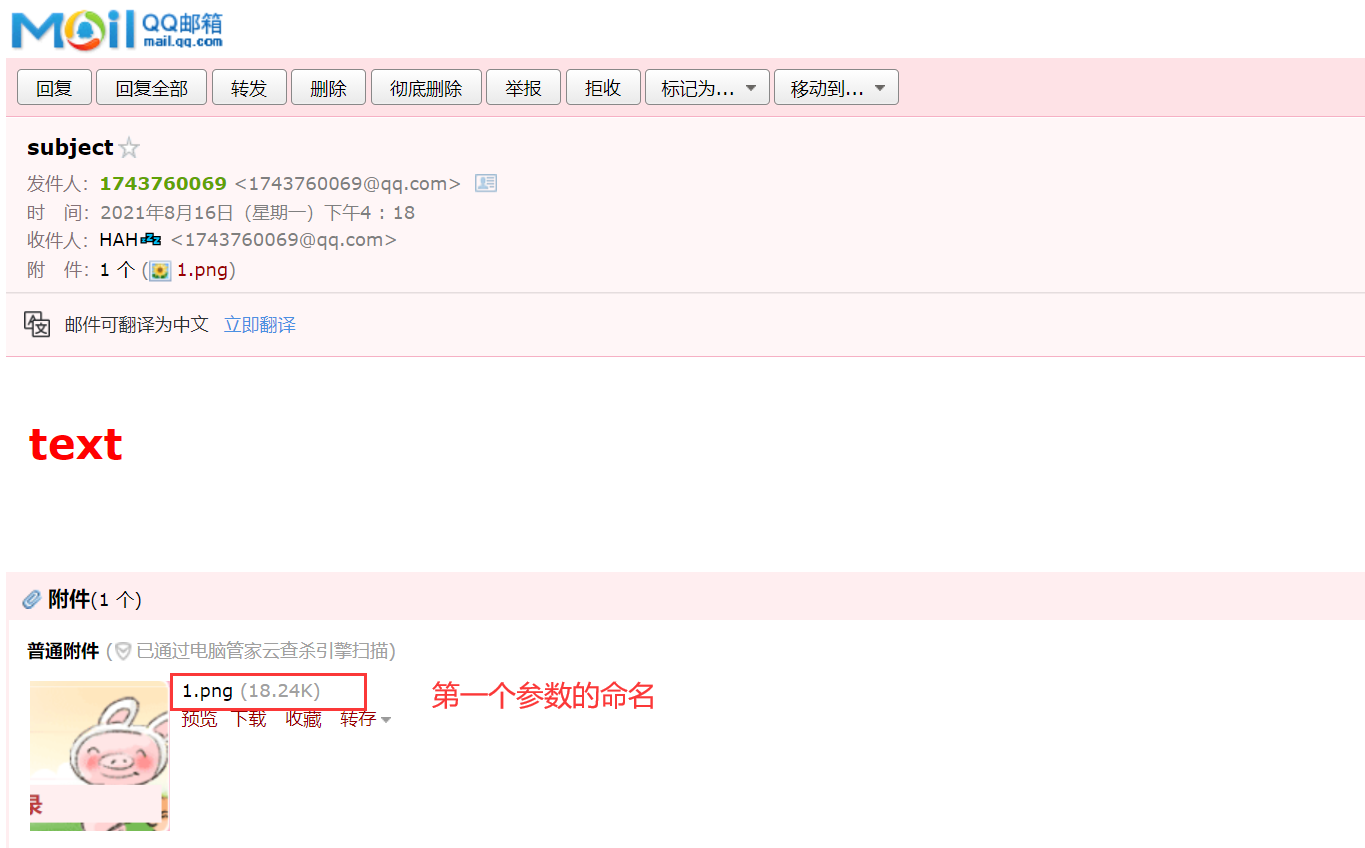
定时任务
实现
和异步任务类似,运行类需要添加注解
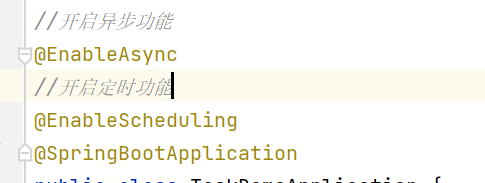
然后service方法也要加注解,这样可以看到刚好在16:40的时候打印了一个hello
@Service
public class ScheduledService {
//设置时间 cron表达式
//秒 分 时 日 月 周几
@Scheduled(cron = "0 40 16 * * 0-7")
public void hello(){
System.out.println("hello");
}
}
cron表达式
简介
Cron表达式是一个字符串,字符串以5或6个空格隔开,分为6或7个域,每一个域代表一个含义
Seconds Minutes Hours DayofMonth Month DayofWeek Year或 Seconds Minutes Hours DayofMonth Month DayofWeek
其中每个元素可以是一个值(如6),一个连续区间(9-12),一个间隔时间(8-18/4)(/表示每隔4小时),一个列表(1,3,5),通配符。由于"月份中的日期"和"星期中的日期"这两个元素互斥的,必须要对其中一个设置?
字符
每一个域可出现的字符如下:
- Seconds:可出现", - * /"四个字符,有效范围为0-59的整数
- Minutes:可出现", - * /"四个字符,有效范围为0-59的整数
- Hours:可出现", - * /"四个字符,有效范围为0-23的整数
- DayofMonth:可出现", - * / ? L W C"八个字符,有效范围为0-31的整数
- Month:可出现", - * /"四个字符,有效范围为1-12的整数或JAN-DEc
- DayofWeek:可出现", - * / ? L C #"四个字符,有效范围为1-7的整数或SUN-SAT两个范围。1表示星期天,2表示星期一, 依次类推
- Year:可出现", - * /"四个字符,有效范围为1970-2099年
特殊字符
每一个域都使用数字,但还可以出现如下特殊字符,它们的含义是:
(1):表示匹配该域的任意值,假如在Minutes域使用, 即表示每分钟都会触发事件。
(2)?:只能用在DayofMonth和DayofWeek两个域。它也匹配域的任意值,但实际不会。因为DayofMonth和 DayofWeek会相互影响。例如想在每月的20日触发调度,不管20日到底是星期几,则只能使用如下写法: 13 13 15 20 * ?, 其中最后一位只能用?,而不能使用*,如果使用*表示不管星期几都会触发,实际上并不是这样。
(3)-:表示范围,例如在Minutes域使用5-20,表示从5分到20分钟每分钟触发一次
(4)/:表示起始时间开始触发,然后每隔固定时间触发一次,例如在Minutes域使用5/20,则意味着5分钟触发一次,而25,45等分别触发一次.
(5),:表示列出枚举值值。例如:在Minutes域使用5,20,则意味着在5和20分每分钟触发一次。
(6)L:表示最后,只能出现在DayofWeek和DayofMonth域,如果在DayofWeek域使用5L,意味着在最后的一个星期四触发。
(7)W: 表示有效工作日(周一到周五),只能出现在DayofMonth域,系统将在离指定日期的最近的有效工作日触发事件。例如:在 DayofMonth使用5W,如果5日是星期六,则将在最近的工作日:星期五,即4日触发。如果5日是星期天,则在6日(周一)触发;如果5日在星期一 到星期五中的一天,则就在5日触发。另外一点,W的最近寻找不会跨过月份
(8)LW:这两个字符可以连用,表示在某个月最后一个工作日,即最后一个星期五。
(9)#:用于确定每个月第几个星期几,只能出现在DayofMonth域。例如在4#2,表示某月的第二个星期三。
举几个例子: 0 0 2 1 * ? * 表示在每月的1日的凌晨2点调度任务 0 15 10 ? * MON-FRI 表示周一到周五每天上午10:15执行作业 0 15 10 ? 6L 2002-2006 表示2002-2006年的每个月的最后一个星期五上午10:15执行
例子
- 0 0 10,14,16 * * ? 每天上午10点,下午2点,4点
- 0 0/30 9-17 * * ? 朝九晚五工作时间内每半小时
- 0 0 12 ? * WED 表示每个星期三中午12点
- "0 0 12 * * ?" 每天中午12点触发
- "0 15 10 ? * *" 每天上午10:15触发
- "0 15 10 * * ?" 每天上午10:15触发
- "0 15 10 * * ? *" 每天上午10:15触发
- "0 15 10 * * ? 2005" 2005年的每天上午10:15触发
- "0 * 14 * * ?" 在每天下午2点到下午2:59期间的每1分钟触发
- "0 0/5 14 * * ?" 在每天下午2点到下午2:55期间的每5分钟触发
- "0 0/5 14,18 * * ?" 在每天下午2点到2:55期间和下午6点到6:55期间的每5分钟触发
- "0 0-5 14 * * ?" 在每天下午2点到下午2:05期间的每1分钟触发
- "0 10,44 14 ? 3 WED" 每年三月的星期三的下午2:10和2:44触发
- "0 15 10 ? * MON-FRI" 周一至周五的上午10:15触发
- "0 15 10 15 * ?" 每月15日上午10:15触发
- "0 15 10 L * ?" 每月最后一日的上午10:15触发
- "0 15 10 ? * 6L" 每月的最后一个星期五上午10:15触发
- "0 15 10 ? * 6L 2002-2005" 2002年至2005年的每月的最后一个星期五上午10:15触发
- "0 15 10 ? * 6#3" 每月的第三个星期五上午10:15触发
范围和列表
有些子表达式能包含一些范围或列表
例如:子表达式(天(星期))可以为 “MON-FRI”,“MON,WED,FRI”,“MON-WED,SAT”
“*”字符代表所有可能的值
因此,*在子表达式(月)里表示每个月的含义,在子表达式(天(星期))表示星期的每一天
“/”字符用来指定数值的增量 例如:在子表达式(分钟)里的“0/15”表示从第0分钟开始,每15分钟 在子表达式(分钟)里的“3/20”表示从第3分钟开始,每20分钟(它和“3,23,43”)的含义一样
“?”字符仅被用于天(月)和天(星期)两个子表达式,表示不指定值 当2个子表达式其中之一被指定了值以后,为了避免冲突,需要将另一个子表达式的值设为“?”
“L” 字符仅被用于天(月)和天(星期)两个子表达式,它是单词“last”的缩写 但是它在两个子表达式里的含义是不同的。 在天(月)子表达式中,“L”表示一个月的最后一天 在天(星期)自表达式中,“L”表示一个星期的最后一天,也就是SAT
如果在“L”前有具体的内容,它就具有其他的含义了
例如:“6L”表示这个月的倒数第6天,“FRIL”表示这个月的最一个星期五 注意:在使用“L”参数时,不要指定列表或范围,因为这会导致问题
字段 允许值 允许的特殊字符
- 秒 0-59 , - * /
- 分 0-59 , - * /
- 小时 0-23 , - * /
- 日期 1-31 , - * ? / L W C
- 月份 1-12 或者 JAN-DEC , - * /
- 星期 1-7 或者 SUN-SAT , - * ? / L C #
- 年(可选) 留空, 1970-2099 , - * /
范例
- 每隔5秒执行一次:*/5 * * * * ?
- 每隔1分钟执行一次:0 */1 * * * ?
- 每天23点执行一次:0 0 23 * * ?
- 每天凌晨1点执行一次:0 0 1 * * ?
- 每月1号凌晨1点执行一次:0 0 1 1 * ?
- 每月最后一天23点执行一次:0 0 23 L * ?
- 每周星期天凌晨1点实行一次:0 0 1 ? * L
- 在26分、29分、33分执行一次:0 26,29,33 * * * ?
- 每天的0点、13点、18点、21点都执行一次:0 0 0,13,18,21 * * ?
分布式系统理论
什么是分布式系统?
- 在《分布式系统原理与范型》一书中有如下定义:“分布式系统是若干独立计算机的集合,这些计算机对于用户来说就像单个相关系统”;
- 分布式系统是由一组通过网络进行通信、为了完成共同的任务而协调工作的计算机节点组成的系统。分布式系统的出现是为了用廉价的、普通的机器完成单个计算机无法完成的计算、存储任务。其目的是利用更多的机器,处理更多的数据。
- 分布式系统(distributed system)是建立在网络之上的软件系统。
- 首先需要明确的是,只有当单个节点的处理能力无法满足日益增长的计算、存储任务的时候,且硬件的提升(加内存、加磁盘、使用更好的CPU)高昂到得不偿失的时候,应用程序也不能进一步优化的时候,我们才需要考虑分布式系统。因为,分布式系统要解决的问题本身就是和单机系统一样的,而由于分布式系统多节点、通过网络通信的拓扑结构,会引入很多单机系统没有的问题,为了解决这些问题又会引入更多的机制、协议,带来更多的问题。。。
RPC理论
两个核心模块:通讯,序列化(用于数据传输)
https://www.jianshu.com/p/7d6853140e13
分布式Dubbo+Zookeeper+SpringBoot
什么是Dubbo
Apache Dubbo是一款高性能、轻量级的开源Java RPC框架,它提供了三大核心能力:面向接口的远程方法调用,智能容错和负载均衡,以及服务自动注册和发现。
结构
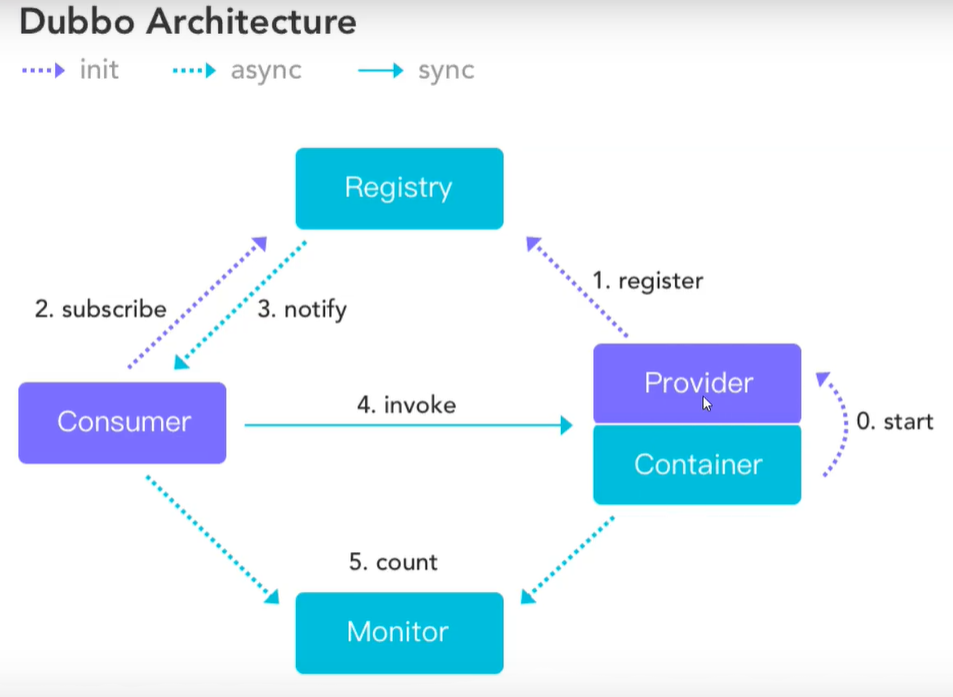
- 服务提供者(Provider):暴露服务的服务提供方,服务提供者在启动时,向注册中心注册自己提供的服务。
- 服务消费者(Consumer):调用远程服务的服务消费方,服务消费者在启动时,向注册中心订阅自己所需的服务,服务消费者,从提供者地址列表中,基于软负载均衡算法,选一台提供者进行调用,如果调用失败,再选另一台调用。
- 注册中心(Registry):注册中心返回服务提供者地址列表给消费者,如果有变更,注册中心将基于长连接推送变更数据给消费者
- 监控中心(Monitor):服务消费者和提供者,在内存中累计调用次数和调用时间,定时每分钟发送一次统计数据到监控中心
zookeeper :注册中心
dubbo-admin:是一个监控管理后台查看我们注册了哪些服务,哪些服务被消费了
Dubbo: jar包
在项目目录下打包dubbo-admin
mvn clean package -D maven.test.skip=true
算了,太难了,这个,也不懂是啥
现状与未来
三层架构+ MVC
架构--->解耦
开发框架
spring
IOC AOP
IOC :控制反转
约泡:
泡温泉,泡茶....,泡友
附近的人,打招呼。加微信,聊天,天天聊, --->约泡
浴场(容器)︰温泉,茶庄,泡友
直接进温泉,就有人和你一起了!
原来我们都是自己一步步操作,现在交给容器了!我们需要什么就去拿就可以了
AOP:切面(本质,动态代理)
为了解决什么?不影响业务本来的情况下,实现动态增加功能,大量应用在日志,事务...等等方面
spring是一个轻量级的Java开源框架,容器
目的︰解决企业开发的复杂性问题
spring是春天,觉得他是春天,也十分复杂,配置文件!
springBoot
springBoot并不是新东西,就是spring的升级版!
新一代avaEE的开发标准,开箱即用!->拿过来就可以用!
它自动帮我们配置了非常多的东西,我们拿来即用!特性:约定大于配置!
随着公司体系越来越大,用户越来越多!
微服务架构--->新架构
模块化,功能化!
用户,支付,签到,娱乐,..... ;
人多余多:一台服务器解决不了;在增加服务器!横向
假设A服务器占用98%资源,B服务器只占用了10% 。--负载均衡;
将原来的整体项目,分成模块化,用户就是一个单独的项目,签到也是一个单独的项目,项目和项目之前需要通信,如何通信?
用户非常多,而签到十分少!给用户多一点服务器,给签到少一点服务器!
微服务架构问题?
分布式架构会遇到的四个核心问题?
1.这么多服务,客户端该如何去访问?
2.这么多服务,服务之间如何进行通信?
3.这么多服务,如何治理呢?
4.服务挂了,怎么办?
解决方案:
springc1oud,是一套生态,就是来解决以上分布式架构的4个问题
想使用springcloud,必须要掌握SpringBoot,因为springc1oud是基于springBoot;
1.spring cloud NetFlix,出来了一套解决方案!一站式解决方案。我们都可以直接去这里拿?
Api网关,zuu1组件
Feign --> Httpclient ---> HTTP的通信方式,同步并阻塞
服务注册与发现,Eureka
熔断机制,Hystrix
2018年年底,NetF7ix宣布无限期停止维护。生态不再维护,就会脱节。
2. Apache Dubbo zookeeper,第二套解决系统
API ∶没有!要么找第三方组件,要么自己实现
Dubbo是一个高性能的基于Java实现的RPC通信框架! 2.6.x
服务注册与发现,zookeeper:动物园管理者(Hadoop , Hive)
没有:借助了Hystrix
3. Springc1oud Alibaba一站式解决方案!
目前,又提出了一种方案:
服务网格:下一代微服务标准,Server Mesh
代表解决方案: istio(你们未来可能需要掌握! )
万变不离其宗,一通百通!
1.API网关,服务路由
2.HTTP, RPC框架,异步调用
3.服务注册与发现,高可用
4.熔断机制,服务降级
如果,你们基于这四个问题,开发一套解决方案,也叫springcloud!
为什么要解决这个问题?‘本质:网络是不可靠的!